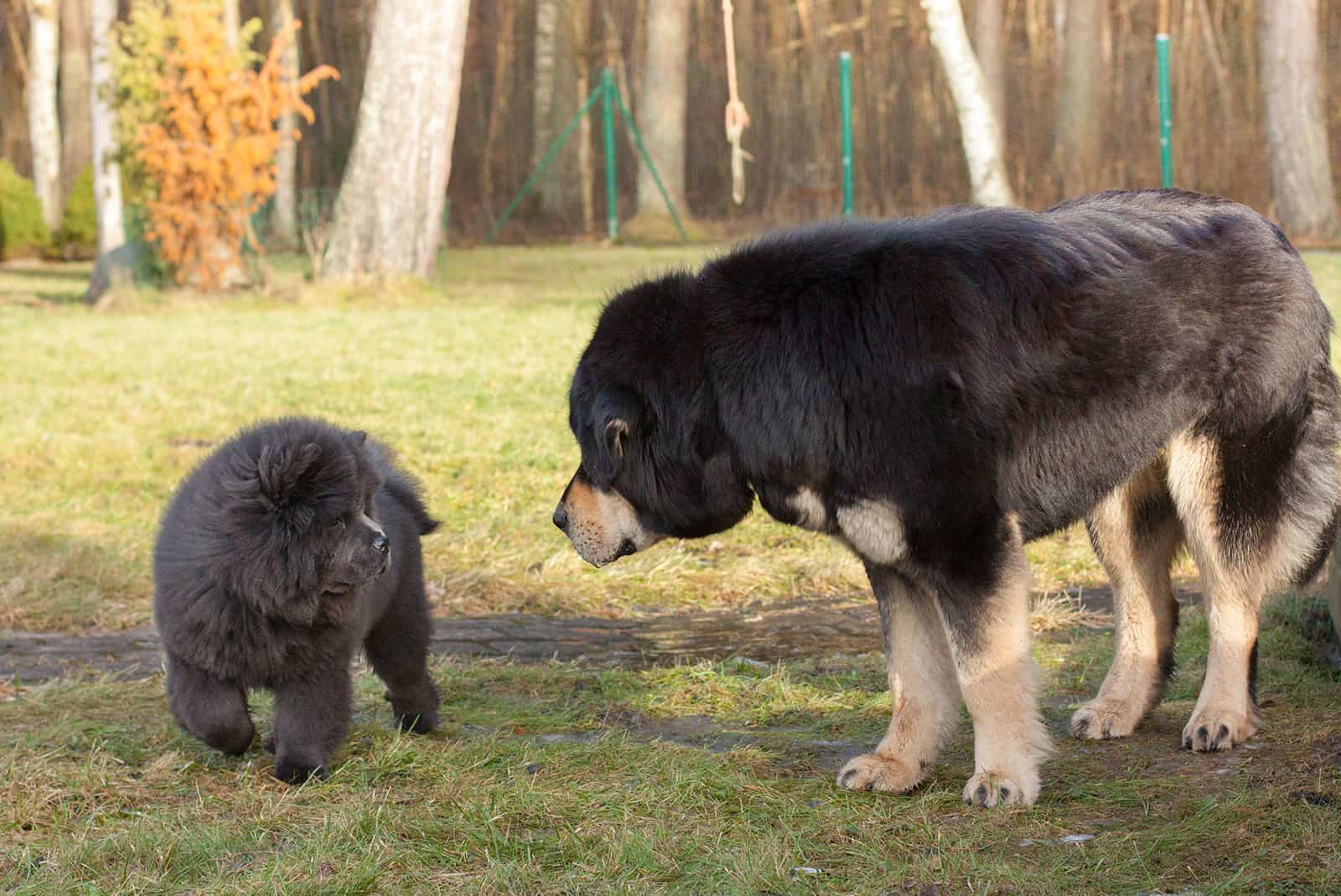Apart from being the third-largest country in the world, China is also known for a myriad of other things, such as its rich cultural heritage, delicious food, and architectural marvels like the Forbidden City and the Great Wall Of China, along with many other factors that contribute to its renown.
China might just be the best example of an ever-changing country that possesses the perfect mix of ancient and contemporary things.
That said, China is also the birthplace of quite a few unique dog breeds, some of which, you might never have heard of before.
From popular dog breeds like the Pekingese to expensive and massive breeds like the Tibetan Mastiff, and everything in between—Chinese breeds of dogs are believed to have been among the first dogs ever to be domesticated.
That’s right, recent scientific research done by the Kunming Institute of Zoology has disputed the previous belief that dogs were first domesticated around 15,000 years ago in central Asia—new findings suggest that the domestication of dogs actually began around 33,000 years ago in ancient China.
Considering that China seems to be the birthplace of the unbreakable human-canine bond that has since only irrevocably strengthened—it’s no surprise that many of today’s dog breeds actually hail from China and that they are still kept as pets by millions of people all around the world.
So, if you’re wondering how many Chinese dog breeds exist, what they look like, and what makes them unique—buckle up, and let’s find out.
Chinese Dog Breeds Ranked From Largest To Smallest
Since canines have been a part of Chinese culture for more than 7 millennia, it should come as no surprise that they have been inextricably woven into Chinese folklore, artwork, and the daily lives of both ordinary and extraordinary Chinese men and women.
From the time they were domesticated, man’s best friends have been utilized as hunters, haulers, guardians, and companions—and Chinese dog breeds are no exception.
Dog breeds that originate from China range from small fluffy breeds, like the Pekingese, through to intelligent hunting dogs like the Chow Chow, to large dog breeds like the Tibetan Mastiff.
Chinese dog breeds come in all shapes and sizes and are as unique and distinct as the diverse regions of China—so we’ve decided to rank these Chinese dog breeds from largest to the smallest, just to make things a bit easier.
So, without further ado, let’s check out 20 Chinese dog breeds and what makes these dogs unique.
1. The Tibetan Mastiff
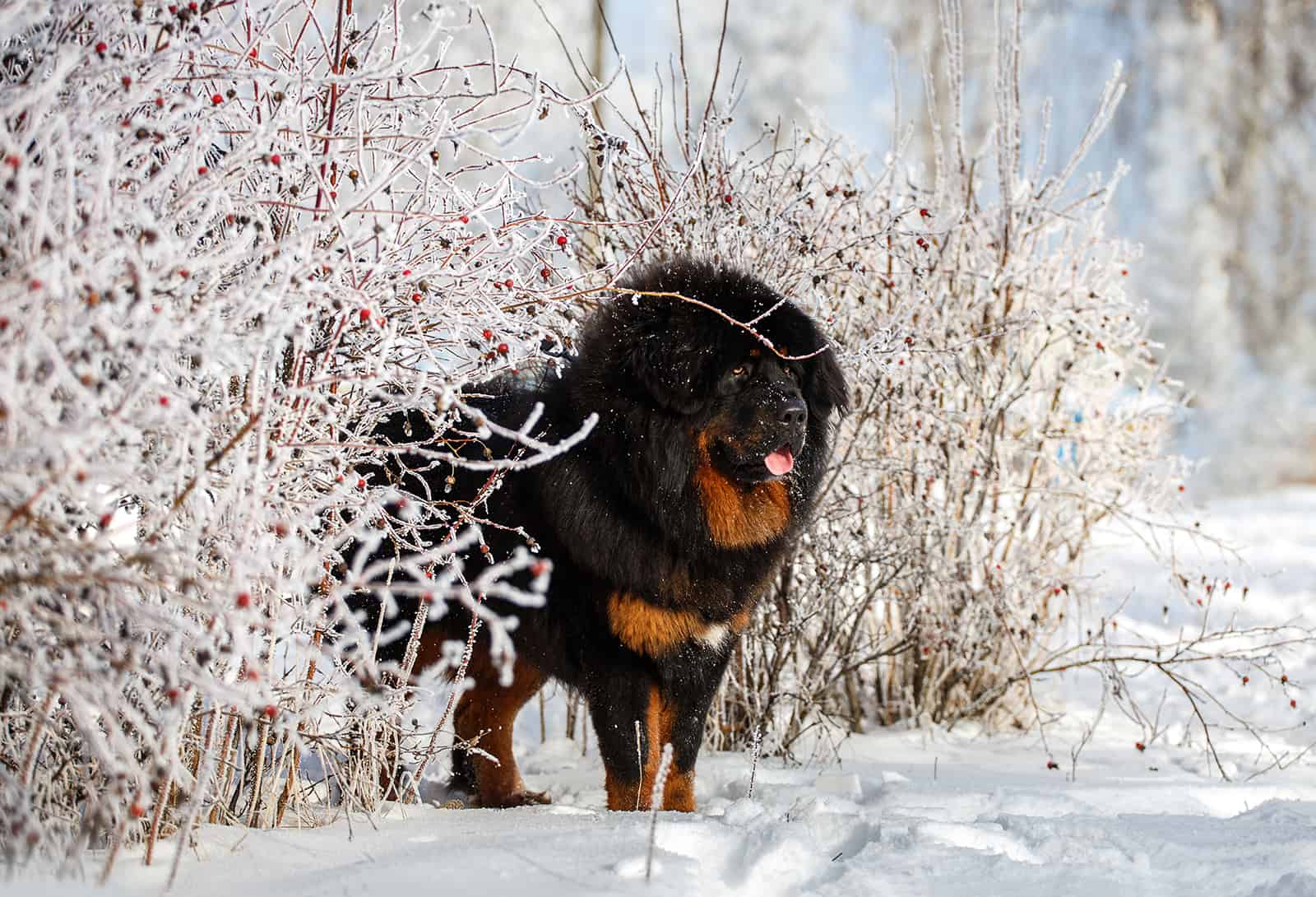
Native to the Himalayan mountains of the Tibetan plateau in China, the gigantic Tibetan Mastiff is one of the largest and oldest breeds of dog in the world—in addition to being one of the most expensive dog breeds.
The Tibetan Mastiff is believed to be the ancestor from which the majority of modern mastiff dog breeds descended.
This watchful and intimidating dog breed has existed for millennia and was originally used as a guard dog and protector against large predators, like wolves and bears, by the Buddhist monks who lived in the monasteries of ancient Tibet.
Historical records show evidence that ancient Greeks, Persians, Romans, Assyrians, and even Genghis Khan himself utilized Tibetan Tibetan Mastiffs as war dogs.
They were also historically favored by Chinese royalty and were used as efficient and relentless hunting dogs—merchants also used them for personal protection when they traveled along the Silk Road.
The breed got its name when the first Tibetan Mastiffs were imported to England as a gift to Queen Victoria in 1847—prior to that they were called Dok-Khyi, which in Tibetan means ‘the nomad dog’.
The Tibetan Mastiff’s Characteristics
Apart from its massive and powerful build, which only adds to its fierce appearance, the Tibetan Mastiff possesses a dense and wooly double-coat that resembles a lion’s mane—regular grooming and bathing are essential to keep a Tibetan Mastiff’s coat healthy.
Temperament-wise, this dog breed is intelligent and very gentle toward its owners, but they’re also known to be self-willed and stubborn—they should be properly trained and socialized early on so that they can be kept in check.
Needless to say, these behemoths are not a good choice for first-time dog owners, since they can sometimes be a handful even for experienced canine enthusiasts.
However, alongside being calm and collected with their loved ones, Tibetan Mastiffs are also very protective and will never allow a stranger to enter their home—which is why they’re a good family guard dog for people who can handle them.
Fun Facts
• Purebred Tibetan Mastiff puppies in the US cost anywhere between $2,000 and $12,000, depending on various factors—but the most expensive Tibetan Mastiff, and the current record holder for the most expensive dog in the world, was sold for a staggering $1.95 million.
• Since Tibetan Buddhism believes in reincarnation, the Buddhist monks of Tibet believe that Tibetan Mastiffs are in fact monks that were reincarnated into dog bodies because they did not make it into Shambhala.
• Some contemporary celebrities that have owned or currently own Tibetan Mastiffs include the Dalai Lama, Bob Dylan, Dwayne “The Rock” Johnson, and Christina Aguilera.
Want to own a Tibetan Mastiff but don’t know where to find a good breeder? We’ve got you covered with our list of the best Tibetan Mastiff breeders in the US.
2. The Chow Chow
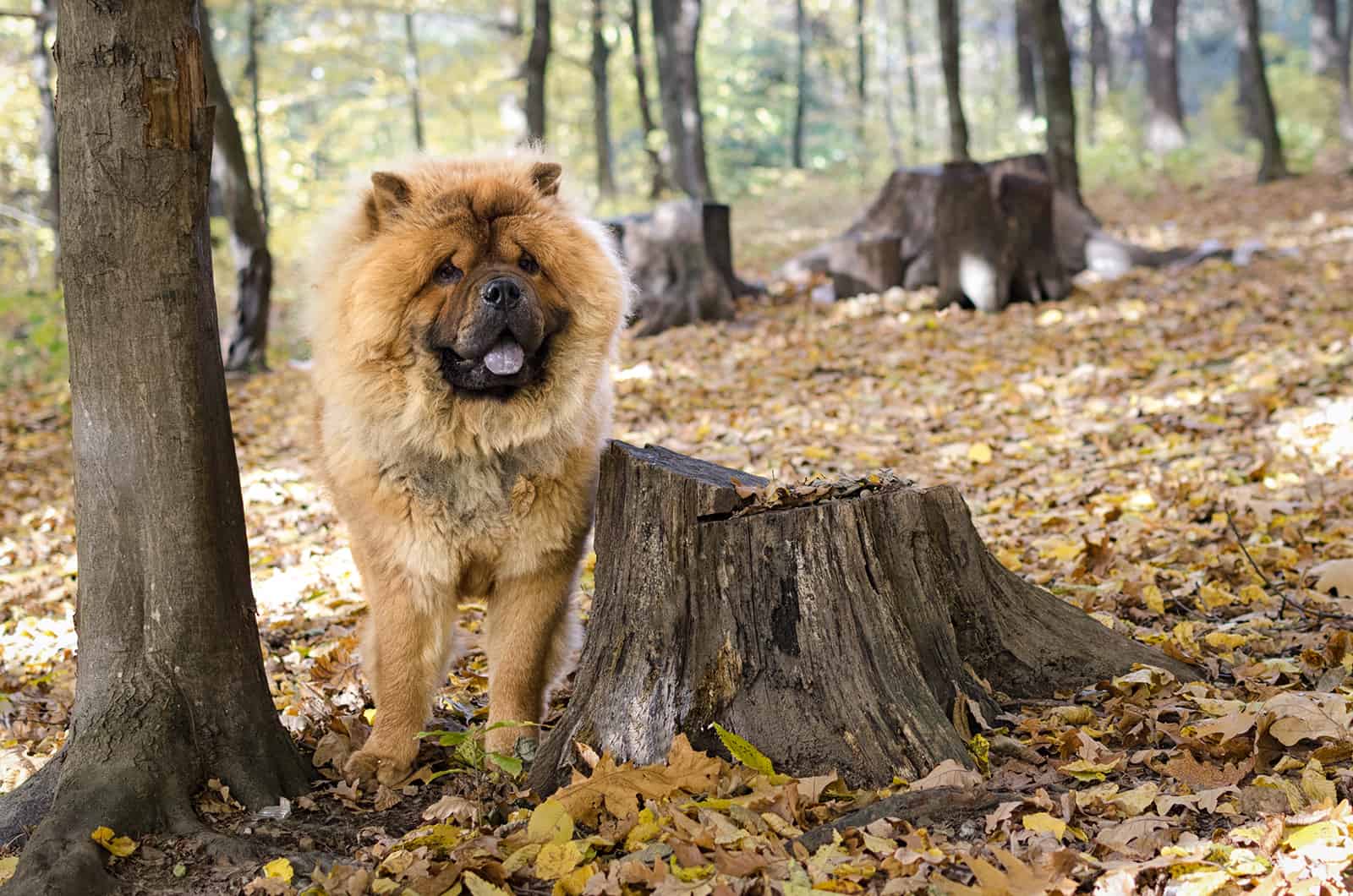
The Chow Chow is a dog breed that is believed to be native to Northern China and belongs to the Spitz family of dogs, which includes breeds like the Japanese Spitz and the Samoyed.
We know that the Chow Chow dog breed originated in China, but the exact time of origin and how it came to be are largely still a mystery—although we do know that it’s one of the oldest extant dog breeds in the world and that its origin can be traced back to the Han dynasty.
Genetic sequencing of nine individual Chow Chows done by BMC Genomics produced evidence that Chow Chows are among the three basal dog breeds (including the Akita Inu and Shar-Pei) that descended from indigenous Chinese dog breeds around 8,300 years ago—the DNA research also showed that Chows are genetically very similar to the wolf.
Chow Chows were originally used as versatile working dogs that excelled at guarding, herding, hunting, and sled pulling—but today, they’re mostly used as show dogs and kept as companion dogs.
The Chow Chow’s Characteristics
The Chow Chow is a unique Chinese dog breed that boasts a beautiful and distinct double coat that comes in two varieties—a smooth and a rough coat.
The rough coat is more common and is thick, coarse, and woolly—it appears thicker and stands off from the body around the neck and head, resembling a lion’s mane.
The smooth coat is also dense and hard but it is smoother to the touch and has no obvious feathering present anywhere on the dog’s body—the most common Chow Chow colors are red, blue, black, cream, and cinnamon.
Temperament-wise, both male and female Chow Chows are often compared to cats, due to their aloof and independent personality—their demeanor is sometimes regal, which is no surprise considering that they were kept as royal companions.
Despite their fierce appearance, Chows are quiet, affectionate, and gentle toward their loved ones—but they’re not exactly fond of too much cuddling.
When properly socialized and trained, Chows make wonderful family members and are able to get along well with children—but they are known to shed a lot, so regular grooming is crucial.
If you want to own your own gentle giant and you need help finding reputable breeders, check out our article on the 8 best Chow Chow breeders in the US.
If you decide to buy a Chow for yourself, you‘ll also need to keep a Chow Chow weight chart close by in order to keep track of your Chow’s physical development.
Fun Facts
• The Chinese emperor of the Tang Dynasty, Gaozu, kept 2,500 Chow Chows as hunting dogs to accompany his 10,000 hunters.
• Some of the earliest depictions of dogs appear in paintings and pottery from the Han Dynasty (206 BC to 22 AD) and they closely resemble the Chow Chow.
• Another strange but true fact about Chow Chows is that they have a blue or black tongue, which is a trait that they share only with the Chinese Shar-Pei. This is considered to be the breed standard for both of these breeds according to the AKC (the American Kennel Club).
3. The Xian Hound
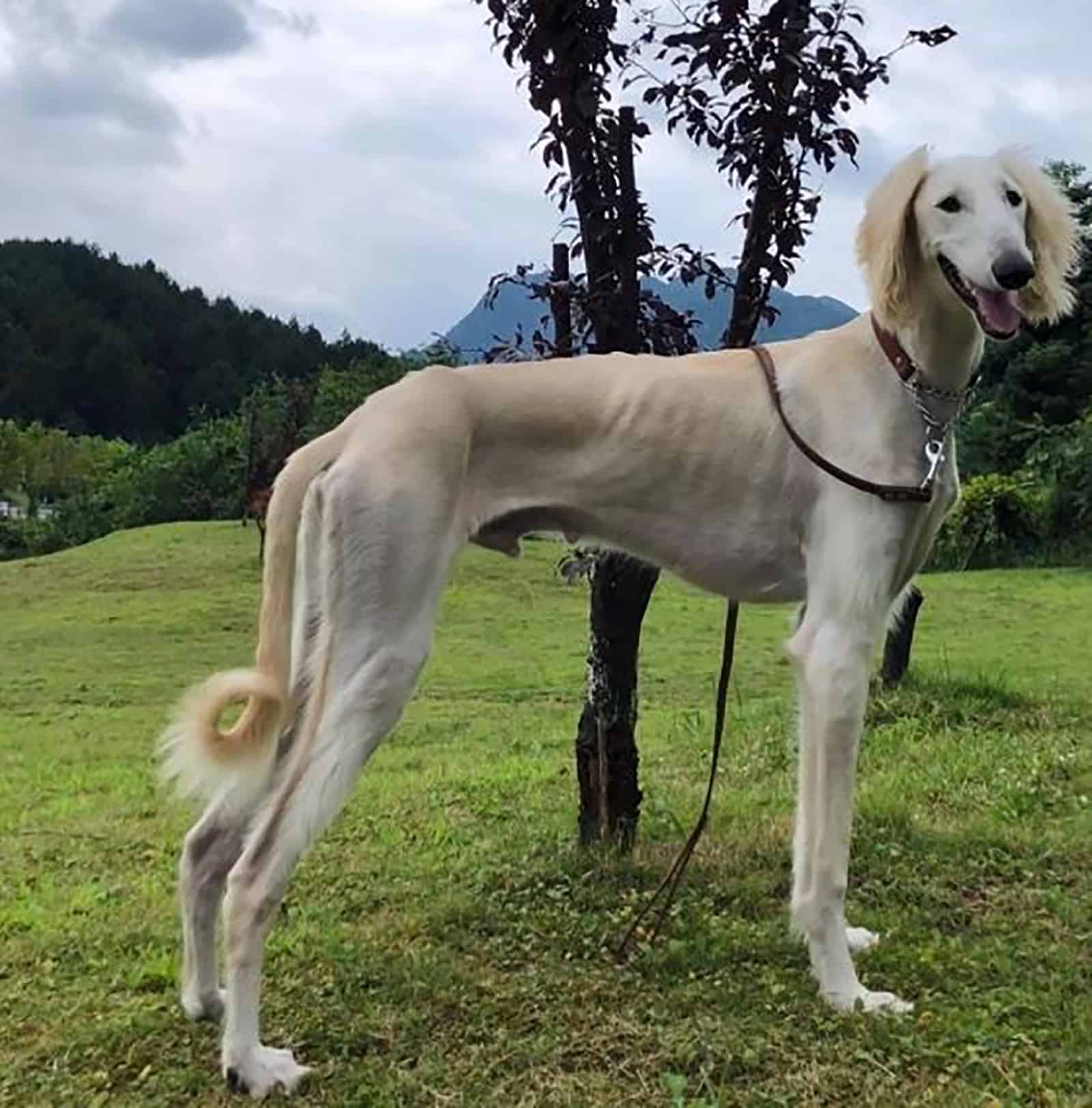
Photo from: @xiaotian_xianhound
Also known as the Shanxi Xigou, the Xian Hound is one of the rarest Chinese dog breeds—some canine experts even believe that the Xian Hound is the predecessor of all extant sighthounds.
The origin of these dogs can be traced back to around 685 AD, when they were used by Chinese emperors for tracking, pursuing, and capturing prey in the open fields due to their incredible hunting instincts.
This unique Chinese dog breed was named after Zhang Xian—the ancient Chinese god of archery who often took the form of a dog that resembled the Xian Hound.
The Xian Hound’s Characteristics
This is an active, agile, and energetic dog breed that was bred to possess endurance, stamina, and a high prey drive—therefore, a Xian Hound needs plenty of daily exercise in order to stay mentally and physically healthy.
Xian Hounds have coats that are short, silky, and smooth, with feathering on their ears, thighs, and tail—they most commonly come in black, blue, white, silver, and red coat colors, and some rare Xian Hounds come in brindle.
Some unique physical traits that Xian Hounds exhibit are a slim waist, long tail, and a narrow, elongated head, along with a raised bridge on their nose that only adds to their elegant appearance.
Temperament-wise, Xian Hounds are aloof and independent, but they are known to have a soft spot for their loved ones—they are affectionate and loyal to their owners, but don’t take kindly to strangers.
They respond well to positive reinforcement training, and when properly trained and socialized from an early age, Xian Hounds make excellent family dogs and guard dogs.
Fun Fact
• The Shanxi Xigou went almost completely extinct when the Chinese government banned normal citizens from hunting—but fortunately, today, the China Kennel Union is working hard to bring this rare breed back from the brink of extinction by collecting DNA samples.
4. Tibetan Kyi Apso
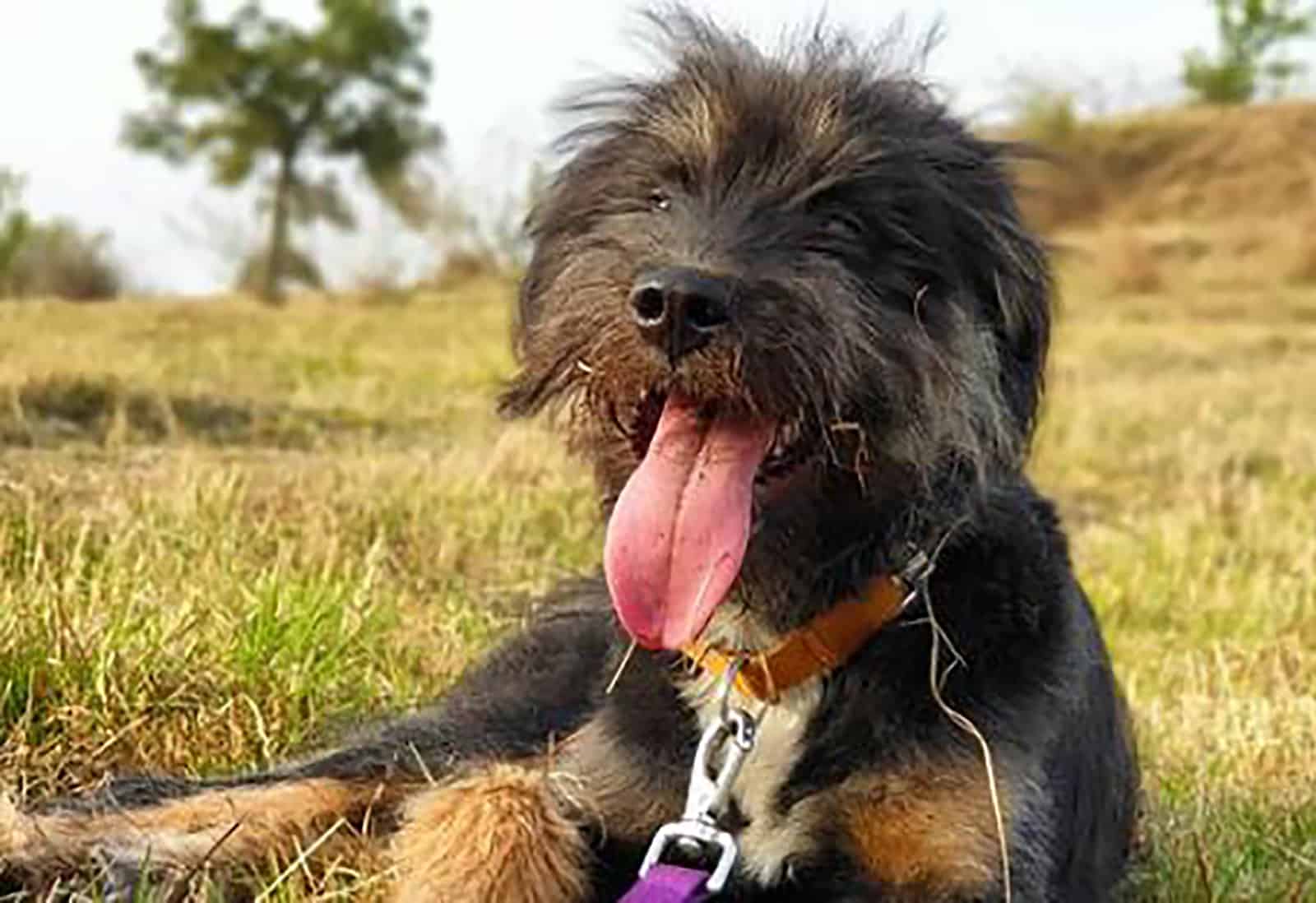
Photo from: @the_bearded_hound
The Tibetan Kyi Apso is one of the six original Tibetan dog breeds—also known as the Apso Do-Kyi, this dog breed’s origin is largely a mystery, but one thing we do know is that they’re ancient and rare.
This dog breed was bred to be a herd protector, personal guard dog, and companion dog, among other uses that the ancient Chinese nomadic tribes had for them.
The Tibetan Kyi Apso resembles the Tibetan Mastiff in many ways, except that the Kyi Apso lacks the characteristic lion’s mane that Tibetan Mastiffs have—instead, they possess a shaggy coat and have a characteristic beard around their muzzle.
The Tibetan Kyi Apso’s Characteristics
Their shaggy double coat is dense and long, which is especially useful for surviving the harsh and freezing climate of Tibet.
Compared to the Tibetan Mastiff, Kyi Apsos are slightly smaller but are more agile and quicker than their Mastiff cousins.
Temperament-wise, Tibetan Kyi Apsos are very intelligent, energetic, independent, and alert, all of which make them good guard dogs—albeit, they are known to be territorial and sometimes stubborn.
Generally loving and affectionate with their owners, Kyi Apsos are also known to be suspicious of strangers and can be aggressive toward intruders.
Fun Facts
• Kyi Apsos are made to wear thick red collars made from yak wool while working—these thick collars help to protect their necks from injury if they come into contact with snow leopards or wolves.
• One famous historical figure that owned a Tibetan Kyi Apso was the 13th Dalai Lama, Thubten Gyatso.
• Female Kyi Apsos are one of the few dog breeds that only have a single heat cycle per year—which is a trait that was previously only observed in wolves.
5. Laizhou Hong
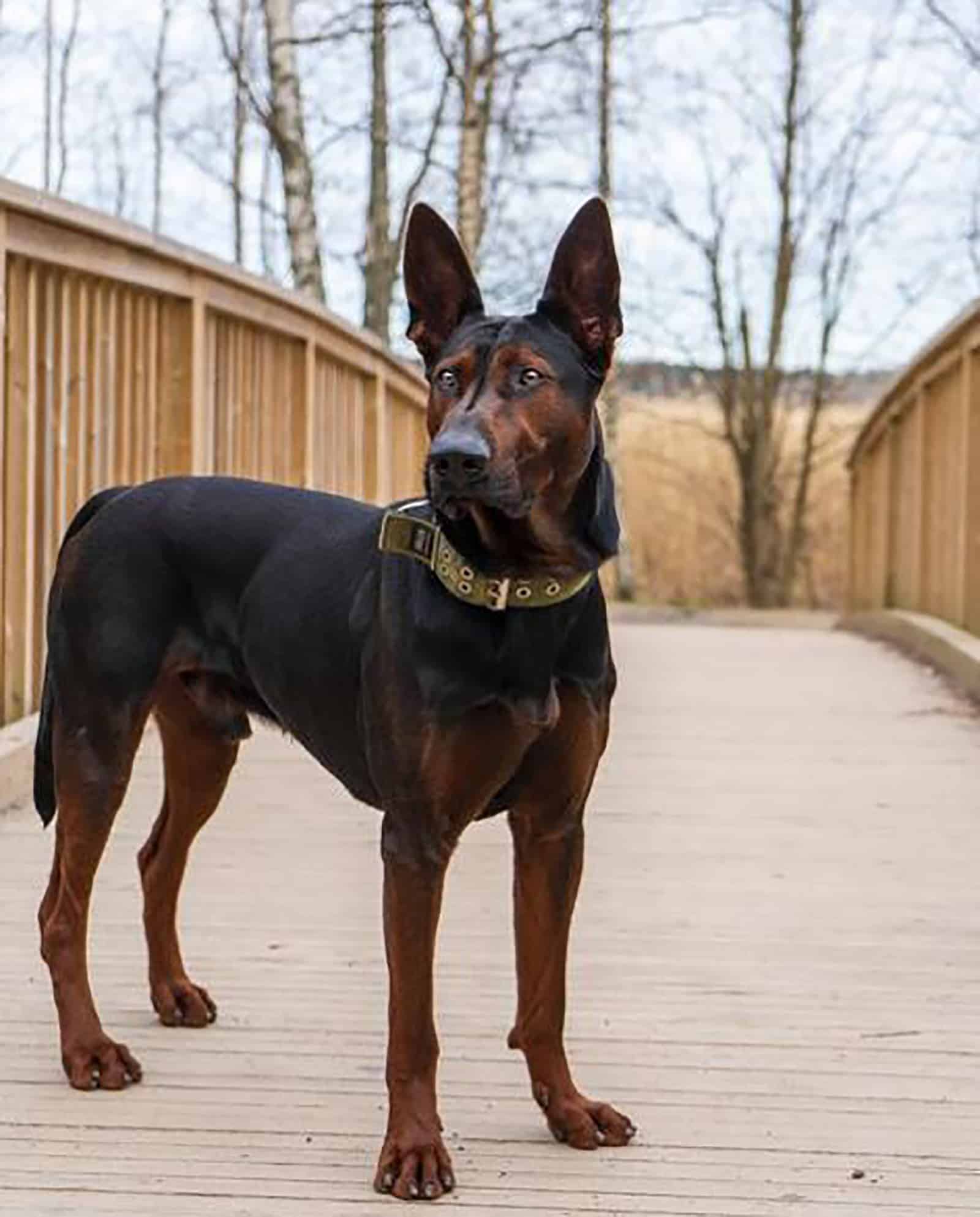
Photo from: @poika_the_red_dog
The next breed on our list of unusual Chinese dog breeds is the Laizhou Hong—a large Molosser-type breed that’s also known as the Chinese Red Dog.
The Laizhou Hong is a powerful, muscular, and sturdy dog that has a large head and a thick neck to support it—they basically look like a mix between the German Shepherd and the Rottweiler, while being stronger and bigger than both respective breeds.
In fact, this dog breed looks like the German Shepherd because German soldiers in the 19th century colonized parts of China, like the Shangdong province, and bred the native Chinese Laizhou Hong with their imported German Shepherds, Great Danes, and Rottweilers—resulting in the Laizhou Hong as we know it today.
The Laizhou Hong is one of the rarest Chinese dog breeds and is extremely hard to come by outside the Laizhou province of China.
The Laizhou Hong’s Characteristics
Although they appear fierce, Laizhou Hongs are known to be calm, friendly, and affectionate dogs when properly socialized and trained.
Apart from being eager to please and extremely loyal to their owners, Laizhou Hongs are also great working dogs and thrive when they have a job to do.
Their versatility allows them to serve as working dogs, excellent guard dogs, and wonderful family companions—some Laizhou Hongs are so devoted to their owners that they’ll even follow them into the bathroom.
Fun Facts
• The Laizhou Hong’s powerful jaw muscles enable them to bite down with a force of 240 PSI, which is comparatively a stronger bite force than that of the Great Dane.
• The Laizhou Hong is officially only recognized by the FCI (the Fédération Cynologique Internationale).
6. The Kunming Wolfdog
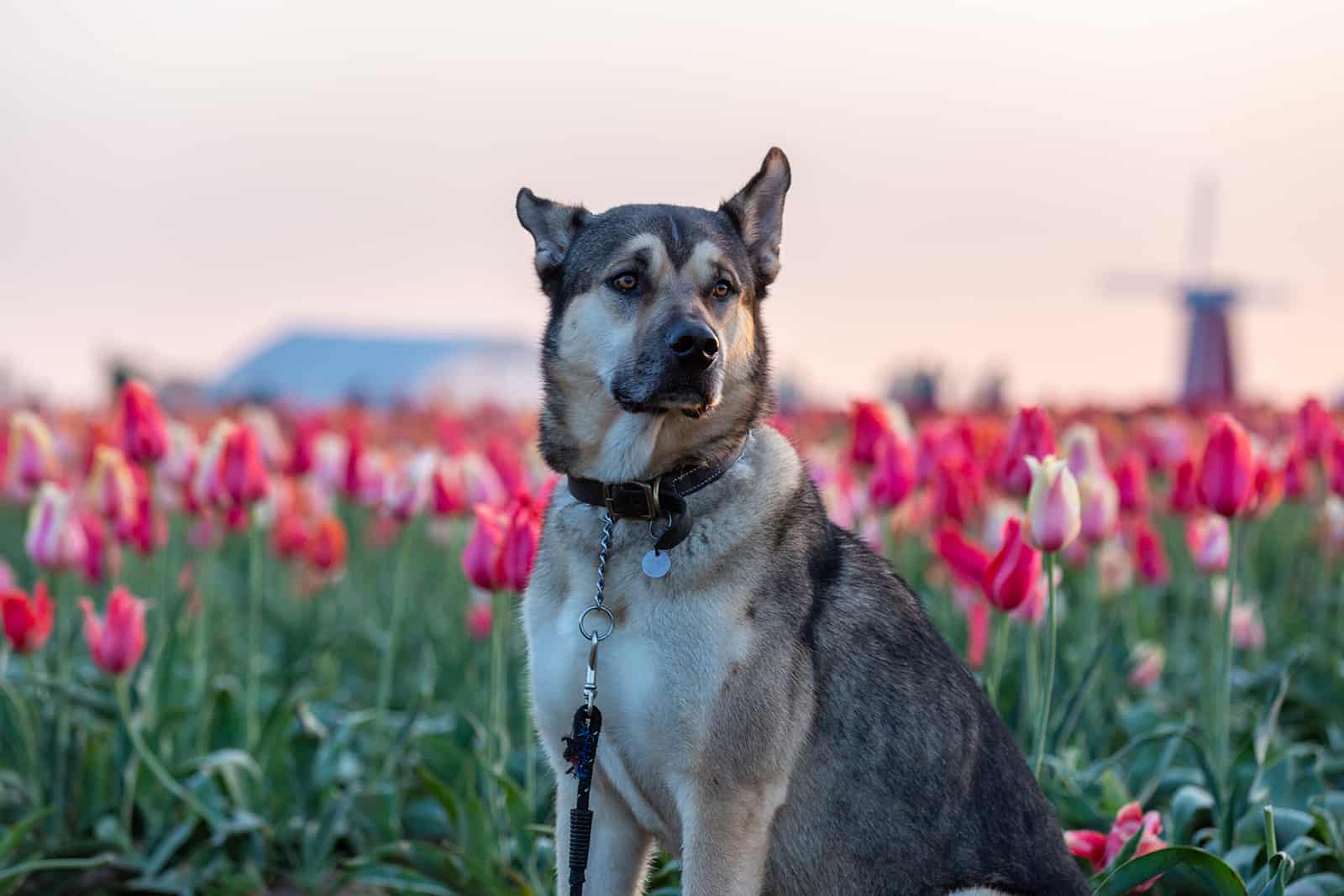
This is another Chinese dog breed that closely resembles the German Shepherd—in fact, it’s often called the Chinese German Shepherd (or just Chinese Shepherd) due to its uncanny resemblance to the GSD.
The Kunming Wolfdog was developed in the 1950s by crossing German Shepherds with other wolf-dog hybrids—they were originally bred for military and police work, such as search and rescue and fire fighting.
Today, Kunming Wolfdogs are still used as police and military working dogs, but are also kept as family dogs—the only reason that they aren’t more popular as family dogs is that they require lots of mental and physical stimulation, which is not something that everyone can provide.
The Kunming Wolfdog’s Characteristics
The Kunming Wolfdog is surprisingly well-behaved towards family members, considering its large size—but it should always be monitored around small children.
This dog breed is eager to please and easy to train due to their high level of intelligence, comparable to the German Shepherd’s—which is why they make ideal service dogs.
However, they are known to be self-willed and independent, so training them might prove difficult for first-time owners—the best way to go about training a Kunming Wolfdog is to consult with a professional dog trainer.
Kunming Wolfdogs are also known to be vocal dogs and will often bark at nothing when they’re stressed or anxious.
Fun Facts
• In 2019, a female Kunming Wolfdog named Kunxun was the first Chinese police dog to be cloned.
7. The Shar-Pei
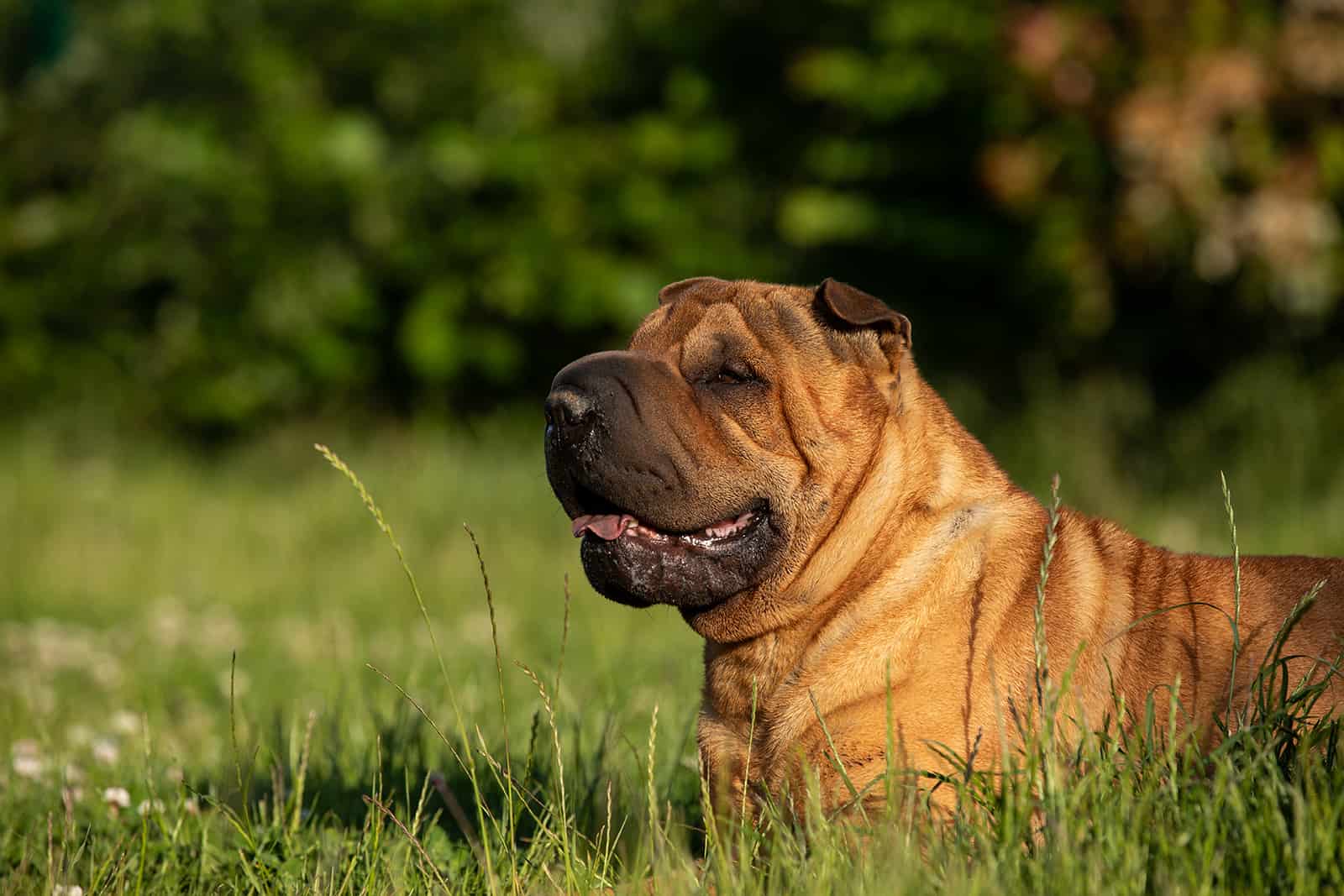
The last of the large Chinese dog breeds on our list is the Chinese Shar-Pei—a wrinkly-coated breed that dates back to around 200 BC.
One of the oldest extant Chinese dog breeds believed to have descended from the Han Dog, the Shar-Pei (which in Chinese means ‘sand skin’) was originally used by the Han dynasty to guard and protect the royal family and their palace.
Its loose and wrinkly skin was meant to function as a type of body armor—and it was selectively bred to have tough skin that would protect it from bites from other animals.
The Chinese Shar-Pei was named the rarest dog breed in the world by The Guinness Book Of World Records in the late ’70s—-this was due to their numbers plummeting because of a high tax on all dogs initiated by the Chinese government in the 1940s.
The Shar-Pei’s Characteristics
Although they haven’t made it onto the list of the top 20 smartest dog breeds in the world, Chinese Shar-Pei dogs are very intelligent and highly adaptive dogs—they’re generally reserved and quiet, gentle with their loved ones, and suspicious of strangers, which makes them ideal family dogs.
Their wrinkly coats come in two types—the horse brush and the bear coat.
Both coat types come in more than 18 coat colors—with the most common color being fawn.
Temperament-wise, the Chinese Shar-Pei is undyingly loyal toward its loved ones but tends to assume an air of indifference around strangers—if they sense some kind of danger, they can quickly become aggressive.
Bone Mouth vs. Meat Mouth Shar-Pei
One important thing to note is that there are two main types of Shar-Pei—the original Chinese Shar-Pei or the ‘Bone Mouth’ and the American or Western Shar-Pei, also called the ‘Meat Mouth’ Shar-Pei.
The original Chinese Bone Mouth Shar-Pei was bred to be a hunting dog—it has a more athletic build, is slightly larger than its American cousin, and has a smooth muzzle.
The American Meat Mouth Shar-Pei is more suited for conformation shows—it has a more compact, heavier build, is slightly smaller than the Bone Mouth, and has a lot more wrinkles on its muzzle and all over its body.
It‘s believed that the American version came to be through the selective breeding of Shar-Pei who had more wrinkly skin in order to produce puppies that look like the Meat Mouth—while in China, breeders wanted to preserve the traditional Bone Mouth Shar-Pei type, so they selectively bred dogs who had less-wrinkly skin.
Another fact worth noting is that Meat Mouth Shar-Pei are more prone to certain health issues, such as breathing problems, eye problems, and skin problems—they have a shorter muzzle and their nostrils are smaller, which means that Meat Mouth Shar-Pei get tired more easily while exercising due to their lack of oxygen intake.
The skin folds around their eyes and all over their body can also cause certain health problems, such as skin fold dermatitis and entropion.
Fun Facts
• The Chinese Shar-Pei breed was practically saved from extinction by LIFE magazine in 1979, when they featured a Shar-Pei on their cover—soon after that, the Shar-Pei’s popularity skyrocketed, and today, they’re among the 200 most popular dog breeds in the US.
• The Shar-Pei, along with the Chow Chow are the only dog breeds that have a blue or black tongue, which is considered a part of its breed standard.
• One of the most interesting and unique Chinese cross-breeds is the Chow-Pei, a mix between the Chow Chow and Shar-Pei.
Medium-sized Chinese Dog Breeds
Now that we’ve gone over all of the large Chinese dog breeds, it’s time to move on to the medium-sized Chinese dog breeds, which include the following five breeds:
• The Chuandong Hound
• The Chongqing Dog
• The Formosan Mountain Dog
• The Xiasi Quan
8. The Chuandong Hound
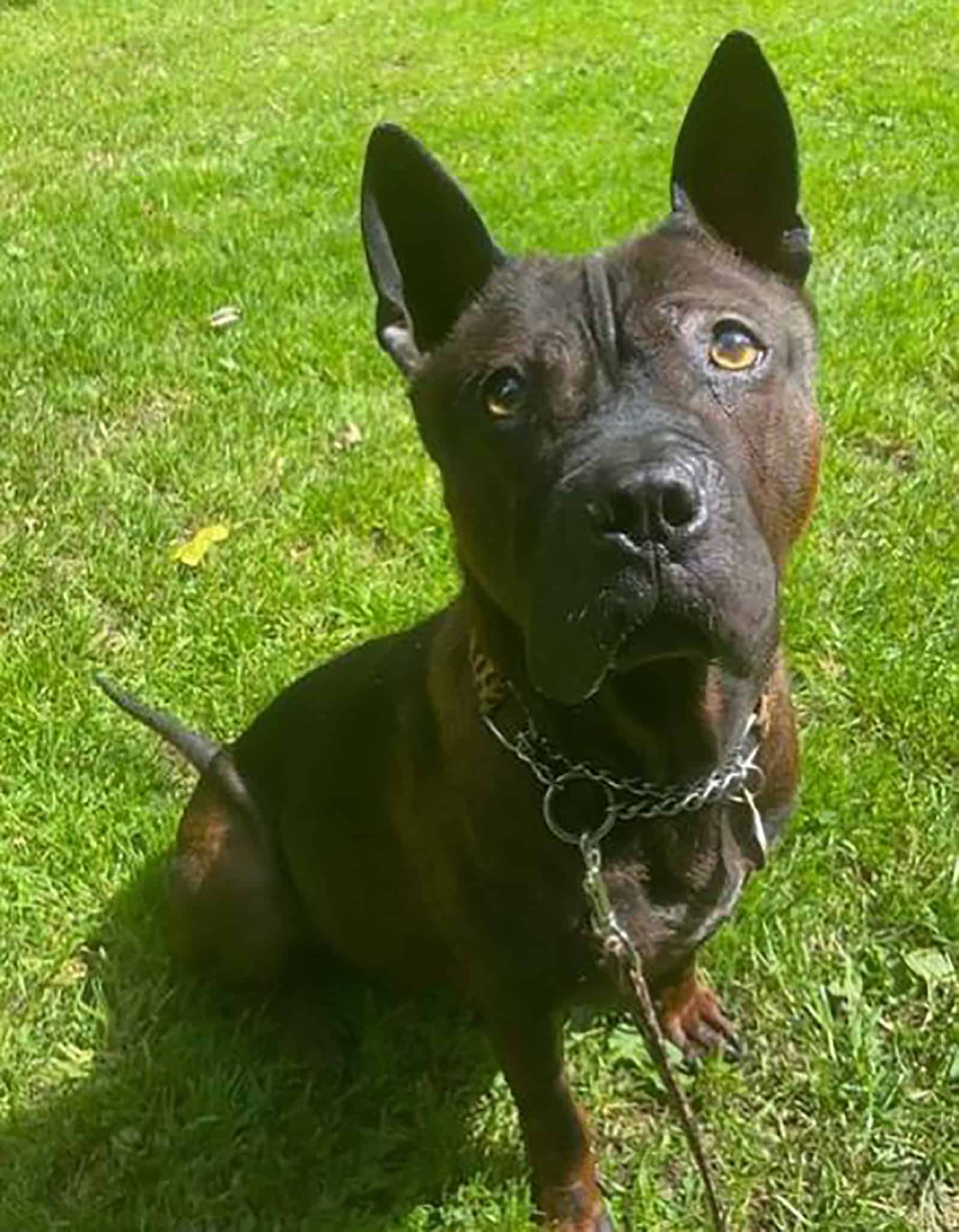
Photo from: @fen_chuandonghound
The first medium-sized dog breed on our list of Chinese dog breeds is the Chuandong Hound – a bulldog-type dog breed that’s also called the Sichuan Hound.
One of the oldest Chinese dog breeds, the Chuandong Hound’s origin can be traced back to around 2,000 years ago in ancient China, where it was bred to be a hunting dog.
Experts believe that the Chuandong Hound descended from the Chongqing Dogs but, at some point in time, they branched off into a separate breed—though these two distinct breeds still share many similarities.
Chuandong Hounds usually come in three coat colors—black, brown, and a deep mahogany red.
Their coats are thin, short, and have a smooth texture—while their head shape and erect ears strongly resemble the appearance of Pitbull-like breeds.
The Chuandong Hound’s Characteristics
The Chuandong Hound is an independent, noble, proud, intelligent, and loyal dog breed that can get along well with other dogs and small children, which is why they’re thought to be good family pets.
Although they’re gentle and loving toward their owners and immediate family, Chuandong Hounds are known to be aloof with strangers and are vigilant guard dogs.
Due to their innate hunting instincts, Chuandong Hounds still possess a high prey drive and need proper training and socialization in order to grow into well-rounded companion dogs—but when properly trained and socialized, they are known to stay by their owner’s side almost 24/7.
When training a Chuandong Hound, it’s important to show dominance in order to curb their self-willed and stubborn nature.
One uncommon trait that this dog breed possesses is an incredibly long life expectancy—although they’re medium-sized dogs, Chuandong Hounds can reach up to 20 years of age.
Fun Facts
• Chuandong hounds are described as having a very ‘cat-like’ personality—they are also able to move their ears separately, they take good care of their hygiene, and they’re as sure-footed as a dog can get.
• Genetic tests show that the Chuandong Hound might be related to the Chow Chow and the Tibetan Mastiff, along with other Chinese dog breeds.
9. The Chongqing Dog
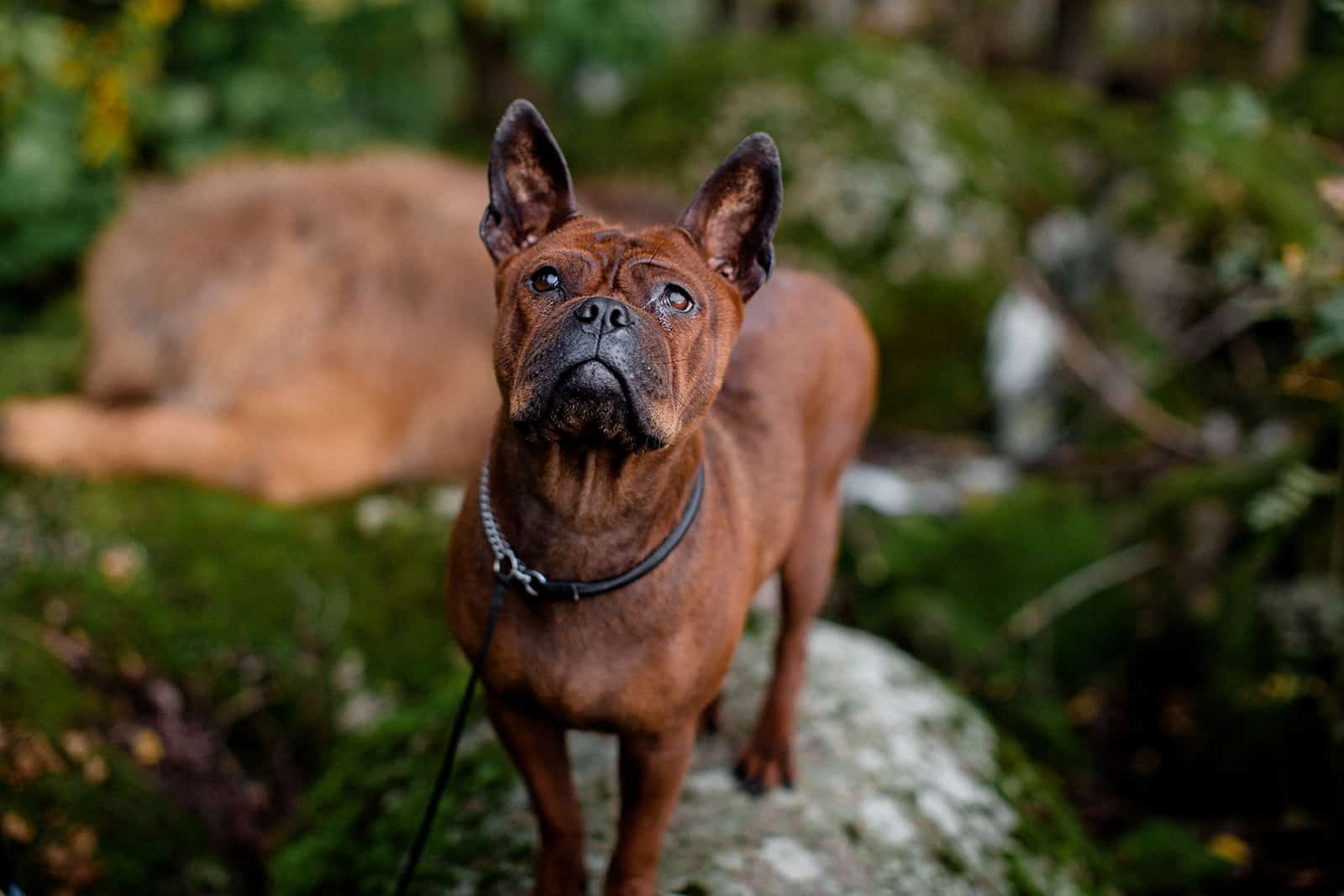
The next dog breed on the list of Chinese dog breeds is the Chongqing Dog, named after the Chongqing province—it’s thought to have originated from the ancient Chinese Chongqing dog.
The main physical difference between the Chongqing Dog and the Chuandong Hound (which stems from the Chongqing Dog) is that the Chongqing is a Molosser-type breed, with a rounded head, shorter muzzle, and flat skull shape—while the Chuandong Hound is slightly larger and has a longer muzzle.
The Chongqing dog looks more like a Bulldog—while its cousin, the Chuandong, is more similar to a PitBull in terms of appearance.
Purebred Chongqing Dogs are a rare sight to see, even in China—although they were originally bred for hunting and working, they’re mostly kept as companion dogs and watchdogs today.
The Chongqing Dog’s Characteristics
Chongqing Dogs are usually affectionate and gentle toward their loved ones, especially toward children—although they are aloof with strangers and are protective of their territory.
Obedient, fairly intelligent, eager to please, and friendly, Chongqing Dogs are good family dogs for people who are able to procure them—since they’re an extremely rare find.
These dogs take their responsibilities seriously and will adapt to the role they are given—if they’re trained to be guard dogs, they will be avid protectors, and if they’re only kept as companions, they will be more well-tempered and easy-going.
Fun Facts
• In the 1980s, archeologists discovered ancient figurines which resemble Chongqing dogs that date back to the Han Dynasty, which means that this breed is at least 2,000 years old.
• There is approximately the same number of Chongqing Dogs as there are Giant Pandas in existence, which makes this dog breed one of the rarest in the world.
• Chongqing dogs have almost gone extinct twice in the last century. The first time was when the Communist party decimated them, and the second time they were on the brink of extinction was when the S.A.R.S epidemic hit China and they were almost wiped out.
10. The Formosan Mountain Dog
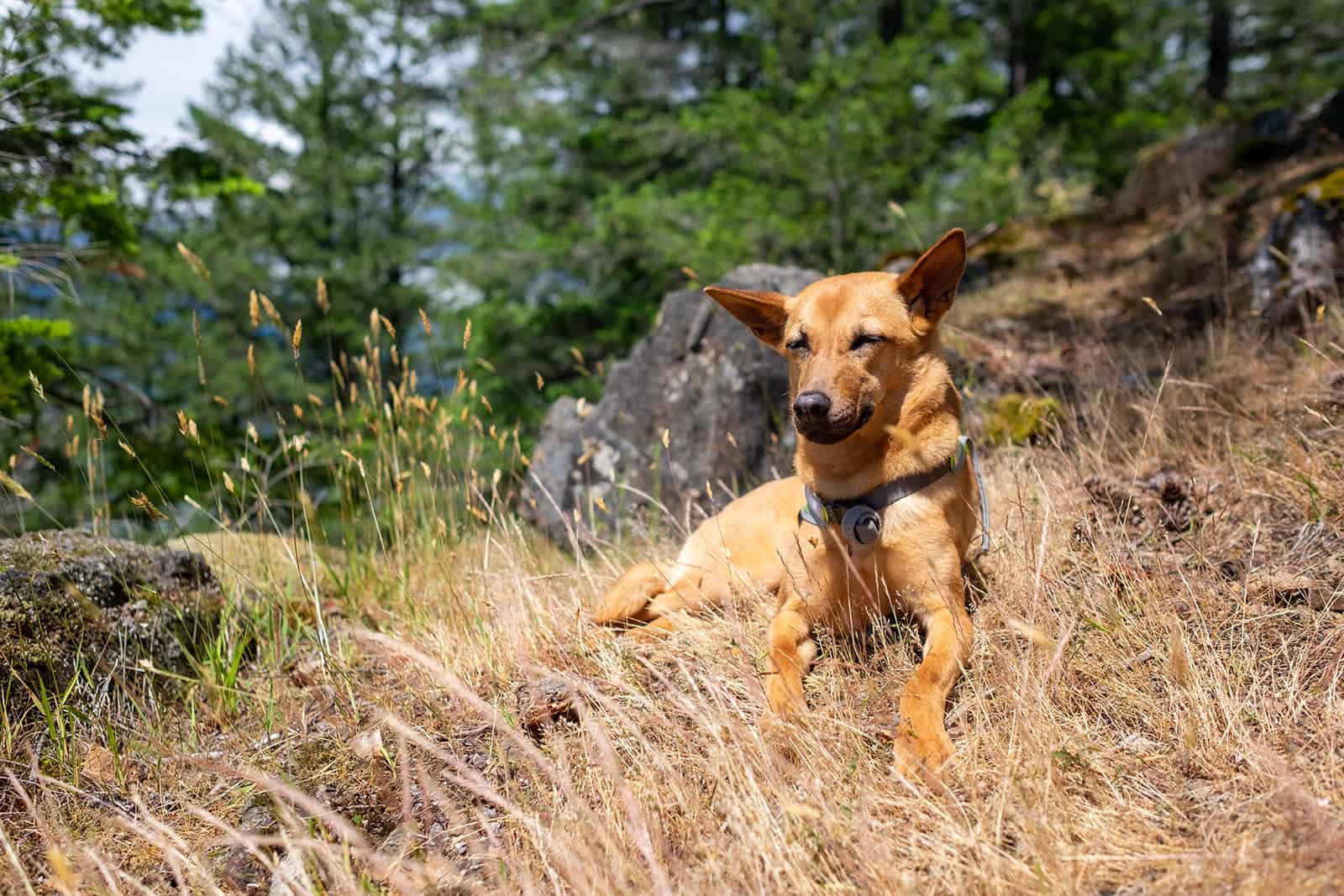
Next up on our list of medium-sized Chinese dog breeds is the Formosan Mountain Dog—a breed that’s been around for at least 20,000 years, which makes it one of the oldest extant breeds in the world.
Also called Tuguo in Chinese, this breed is actually from Taiwan and not from mainland China—in fact, Formosa is another name for the island of Taiwan, hence the name of the breed.
Even though their name would lead you to believe that they’re only found in mountainous regions, Formosan Mountain Dogs can be found all over the streets of Taiwan, both in large metropolitan areas and small rural ones.
These dogs have adapted well over the centuries and are able to easily coexist with humans—they’re popular dogs and many of them are used by villagers in rural areas for hunting, police use them for search and rescue, and tons of families keep them as family pets.
The Formosan Mountain Dog’s Characteristics
The Formosan Mountain Dog is athletically built and has a long, curved tail, along with a triangular head—its coat is usually smooth and can come in white, black, brindle, and fawn colors.
Temperament-wise, these dogs are eager to please, intelligent, obedient, and loyal to their owners, but are also known to be bold, alert, and vigilant when it matters most—which is why they’re good family dogs.
If trained and socialized properly, Formosan Mountain Dogs are even able to learn tricks on command and perform pretty much any other given task, but they’re also high-energy dogs that are best suited to active individuals.
Although they’re a fun breed to have around the house and are good with older children, they do shed heavily twice a year and are not hypoallergenic—which might be a problem for allergy-sufferers.
Fun Facts
• Due to the lack of conservation efforts by the Taiwanese government, the number of Formosan Mountain Dogs is dwindling and they are nearing extinction.
• Formosan Mountain Dogs were cross-bred with military German Shepherds in WWI to produce guard dogs for highway construction workers.
• The Formosan Mountain Dog breed is so old that it existed in Taiwan before humans settled there—a fact that only cements its status as one of the oldest breeds in the world.
11. The Xiasi Quan
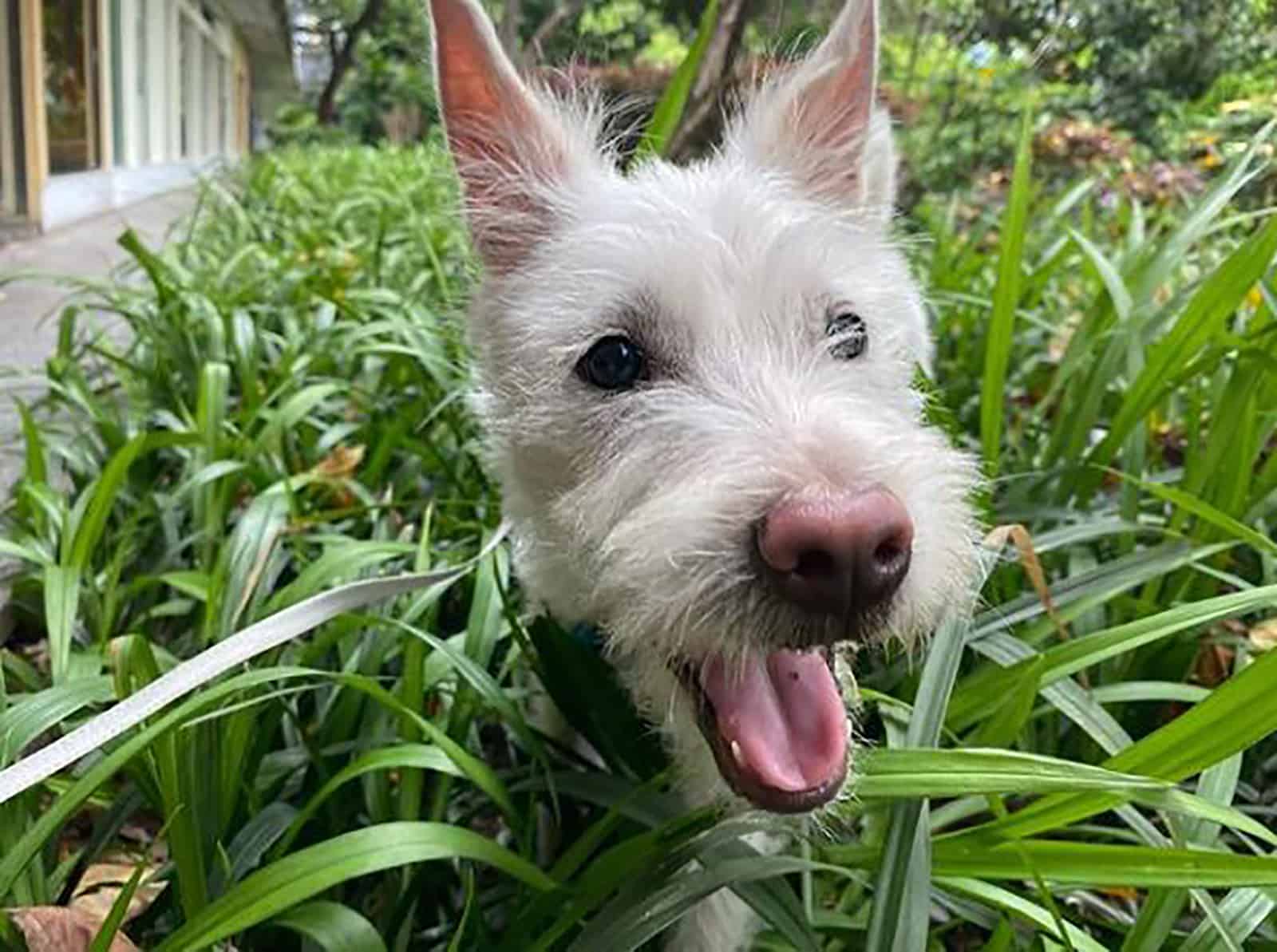
Photo from: @sachelledeline
The last medium-sized breed on our list of Chinese dog breeds is the Xiasi Quan—a dog that originated in the village of Xiasi, in the Guizhou province of China, and was developed to serve as a hunting companion and working dog.
The Xiasi Quan boasts a characteristic wiry coat that’s always white or cream-colored and comes in three different lengths.
This dog breed has all the qualities of a competent hunting dog—incredible olfactory prowess, remarkable endurance, and the agility of a cat. Their high prey drive also enables them to spend hours hunting without breaking a sweat.
The Xiasi Quan’s Characteristics
Xiasi Quan dogs are intelligent, eager to please, agile, quick, obedient, and vigilant—their versatility is the reason why they’re kept as family pets, but also as hunting dogs and working dogs.
When kept as family dogs, Xiasi Quan dogs are affectionate, loving, and gentle with their owners, but are also alert, vigilant, and protective.
Even though until recently they were made to fight boars in competitions, Xiasi Quan dogs are not aggressive by nature and get along well with other dogs and small children—they’re tolerant and calm but are not overly cuddly.
Fun Facts
• Xiasi Quan are believed to bring luck, prosperity, and wealth to any family who keeps one as a family pet.
• Unfortunately, Xiasi Quan dogs are nearing extinction and only a small number of them remain in the Guizhou province of China.
Small Chinese Dog Breeds
Now that we’ve covered the large and medium-sized Chinese dog breeds, it’s finally time to get down and meet the smallest of all the extant Chinese Dog Breeds, which include:
• The Pekingese
• The Shih Tzu
• The Pug
• The Japanese Chin
• The Chinese Crested
•The Lhasa Apso
• The Tibetan Spaniel
• The Tibetan Terrier
• And the Manchurian Hairless
12. The Pekingese
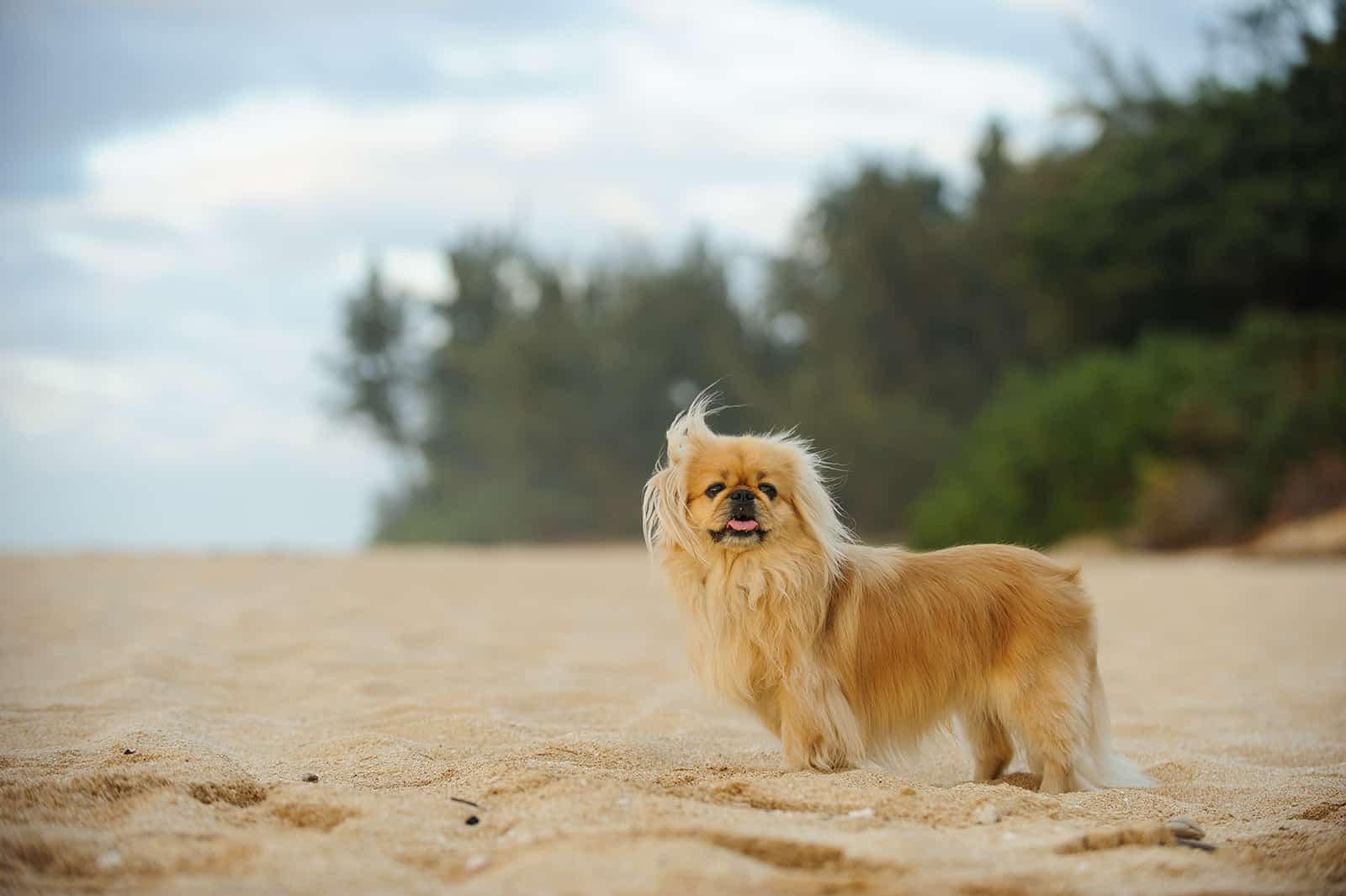
The first and most popular of all the small Chinese dog breeds is the Pekingese—a royal lap dog whose origin can be traced back to at least 2,000 years ago.
This toy dog breed was bred as a companion dog for ancient Chinese royalty and was considered sacred—Pekes were believed to be small lions that were shrunken down by Buddha himself, hence why they were originally called little lion dogs or sun dogs.
The breed got its name after the Chinese capital of Peking (which is not called Beijing) and it is one of the most popular toy dogs in the world.
This small, fluffy dog breed is known for its amiable personality and characteristic golden coat—Pekingese dogs are the ideal choice for anyone who wants an adorable cuddle-buddy with a big personality.
The Pekingese’s Characteristics
Even though they were bred to warm the laps of royalty, Pekingese dogs are sometimes so dignified and self-willed that they won’t settle into just anyone’s lap, which is symbolic of their royal roots—ironic, isn’t it?
Although they’re generally cheerful, affectionate, and playful with their family—Pekes are also aloof toward strangers and can even be a bit aggressive.
Pekingese dogs also tend to be stubborn sometimes, which is why they‘re often mistaken as lacking in intelligence—when in reality, being strong-willed is just an inherent trait in this Chinese dog breed.
If you like small dog breeds, we have a special treat we think you should also check out – the teacup Pekingese!
Fun Facts
• An ancient Chinese folk tale tells the story of how the Pekingese came to be—it says that they were created as a cross between a marmoset and a lion.
• Pekingese dogs were held in such high regard in ancient China that stealing one was punishable by death.
• A Pekingese dog was one of the only two dogs that survived the sinking of the Titanic.
13. The Lhasa Apso
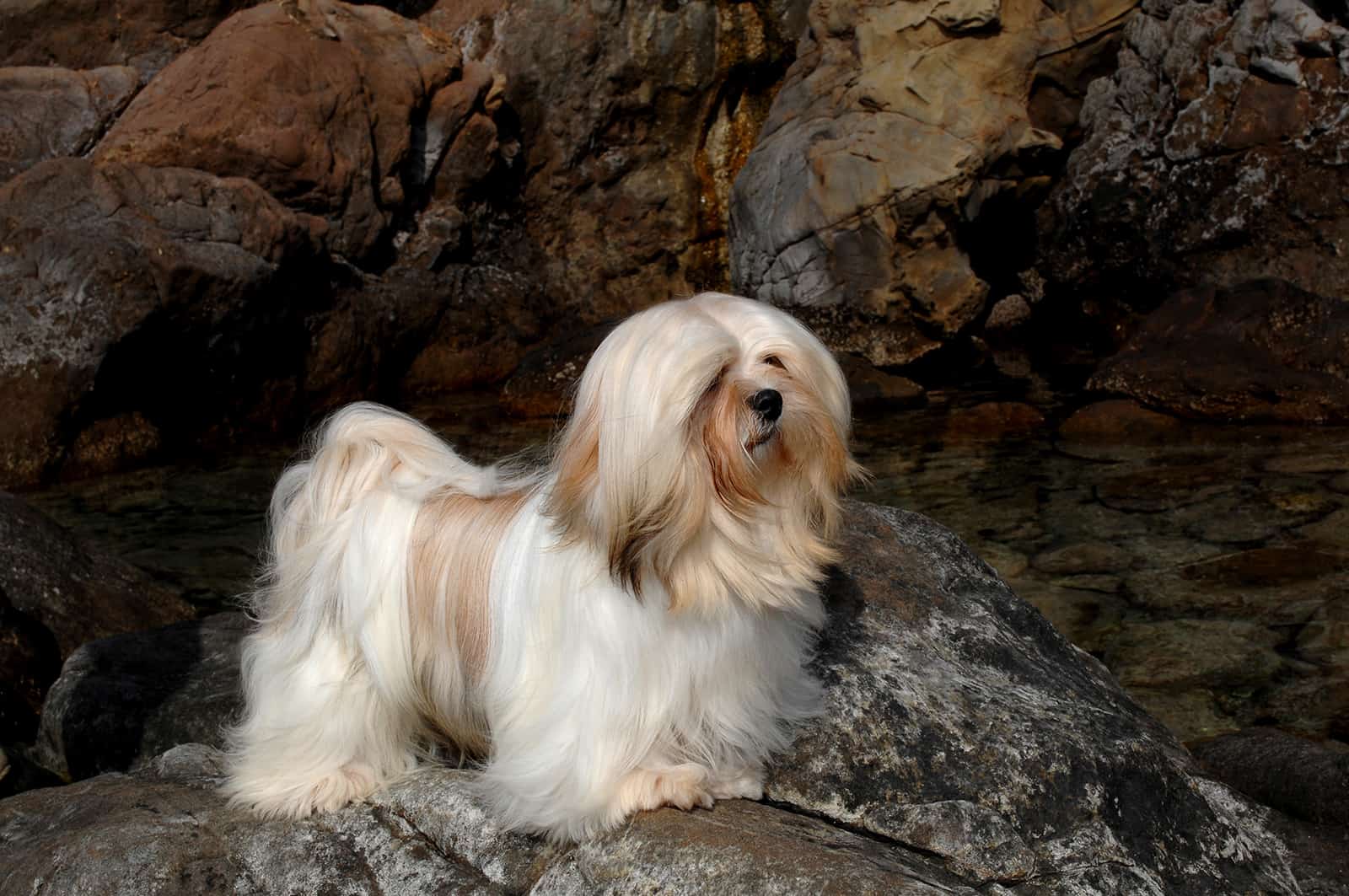
The next small dog breed on our list of Chinese dog breeds is the Lhasa Apso—a toy dog breed that originated around 800 AD in Tibet and was used by Tibetan monks in the Himalayas as a companion dog and watchdog.
The name Lhasa Apso was given to these dogs because Lhasa is the capital of Tibet and “Apso” means bearded—so basically, these dogs are named bearded Lhasa dogs.
Just like the Pekingese, Lhasa Apsos were adored by many members of the royal courts in ancient China and are still extremely popular today—although you don’t have to be royalty to own one now.
The Lhasa Apso’s Characteristics
Lhasa Apsos are fun-loving, affectionate, playful, and sometimes mischievous—they are very friendly and get along well with almost all other dogs and small children, which makes them a good choice for all types of families.
Although Lhasa Apsos are not the most trainable dogs and are known to be stubborn, they make up for their hard-headedness with an amiable attitude and goofy personality.
However, these fluffy little dogs are courageous and alert, which are traits that make them excellent watchdogs—probably due to them being bred for this specific purpose.
If you want to buy a Lhasa Apso puppy for yourself, check out our article on the 4 best Lhasa Apso breeders in the US.
Fun Facts
• Just like the Pekingese, Lhasa Apsos are considered to be sacred dogs—Tibetan Buddhist monks believed that Lhasa Apsos were reincarnations of their sacred Lamas.
• Lhasa Apsos are believed to bring good luck—and the first Lhasa Apsos ever introduced into the US were given as a gift from Thubten Gyatso (the 13th Dalai Lama) to C. Suydam Cutting, who is credited for the subsequent development of the breed in the US.
• Although the average life expectancy of a Lhasa Apso is between 12 and 15 years, some are known to live as long as 20 years—the oldest Lhasa Apso ever recorded, lived to be 29 years old.
14. The Shih Tzu
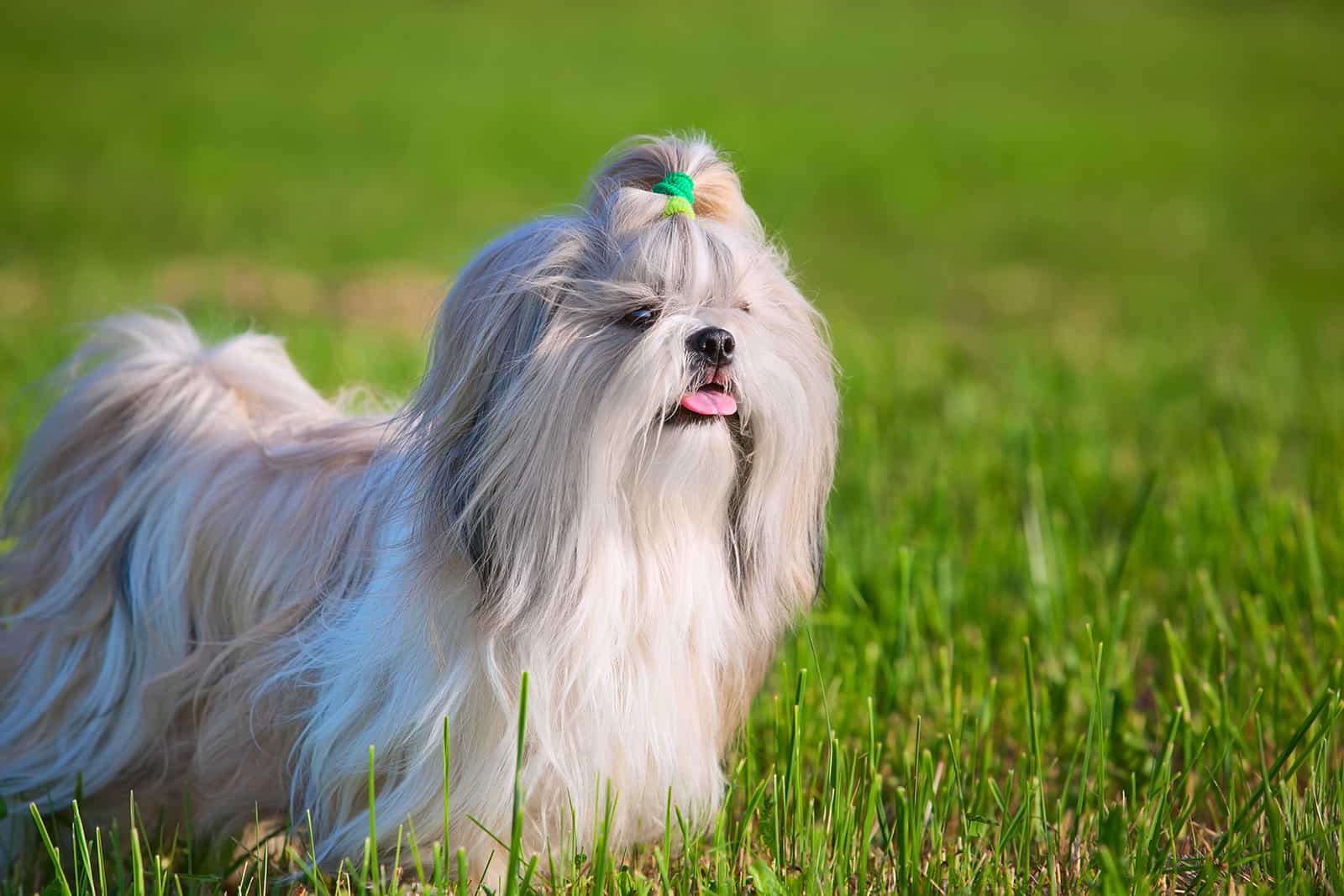
The next small dog breed on our list of Chinese dog breeds is the Shih Tzu (which literally means ‘lion dog’ in Chinese)—a lap dog that was developed from cross-breeding the Pekingese and the Lhasa Apso dog breeds.
Both male and female Shih Tzus are known and adored all around the world for their lovable temperament, affectionate nature, and lap-warming skills—and they have been melting the hearts of dog lovers everywhere for at least a thousand years.
During the Ming dynasty’s rule, the Shih Tzu was a favored companion dog and is one of the dogs that are considered sacred—they were held in such high regard that Chinese royals would never sell, trade, or give any Shih Tzus away for any reason.
The Shih Tzu’s Characteristics
Shih Tzus come in a variety of coat colors, which include red, blue, white, black, black and white, liver, gold, brindle, and the rare colored silver Shih Tzu.
Their long coats can be trimmed and styled to almost any fashion the owner chooses, so it‘s no surprise that Shih Tzu haircuts are a popular topic of discussion among dog hairstyle aficionados.
Temperament-wise, Shih Tzus are friendly, affectionate, and eager to please dogs that are well suited for apartment living due to their small stature—although their clinginess might sometimes be too much for some owners, as some Shih Tzus never want to leave their owner’s side.
Although they’re small, they’re a relatively energetic breed that needs plenty of fresh air and a bit of exercise in order to stay healthy and content—they’re best suited for people who have plenty of time to dedicate to them.
Shih Tzus are also known to be low-shedding and hypoallergenic dogs, so they’re a good choice for people who suffer from dog hair allergies.
If you want to own a Shih Tzu puppy but don’t know where to look for one, check out our article on the top 15 Shih Tzu breeders in the US.
Fun Facts
• A surprising fact is that Shih Tzus (along with their parent breed ancestors, the Lhasa Apso and the Pekingese) are genetically one of the closest relatives of gray wolves, along with breeds like the Samoyed, Akita Inu, and Siberian Husky.
• Some contemporary celebrities that have owned or currently own Shih Tzus include Bill Gates, Colin Farell, Beyonce, Miley Cyrus, and Mariah Carey.
• In ancient China, members of the commonwealth were not allowed to own Shih Tzus, and owning one illegally was punishable by death.
15. The Pug

If you’re surprised that the Pug is on the list of Chinese dog breeds, you’re not the only one—but the fact is that Pugs are one of the oldest breeds of dog in the world, their roots can be traced back as far as 400 BC in China.
Just like our previous small Chinese dog breeds, Pugs were used as companion dogs by ancient Chinese royalty, but were originally used by Buddhist monks as companions—and their popularity is still going strong after thousands of years.
The characteristic flat-faced appearance that can be observed in most small Chinese dog breeds was a trait that was sought-after.
The Pug’s Characteristics
Pugs are a breed of brachycephalic dogs that are adored all around the world for their cute and cuddly appearance, coupled with a personable temperament.
They come in four basic colors and variations of these colors—and while they‘re among the most popular dog breeds in the US, they are also very expensive to obtain and maintain.
They’re also known for being one of the most stable and sociable dog breeds and adapt well to any environment.
Easy-going, laid-back, friendly, and affectionate, Pugs get along well with other dogs and are great with small children—in fact, they’re so friendly that they’re known as velcro dogs, which is no surprise considering that they were bred for companionship.
However, Pugs are known to be prone to certain hereditary health issues, such as brachycephalic obstructive airway syndrome, skin problems, Pug dog encephalitis, etc.
If you want to buy a Pug, make sure to source your new puppy from one of the best Pug breeders in the US.
Fun Facts
• From 1740 to 1748, there was a secret Freemasons society named “The Order Of The Pug”, which was comprised of a group of Catholics who were previously prevented from becoming Freemasons by the Pope at the time.
• A group of Pugs is called a ‘grumble’—this is a nod to their Hollandic name ‘mopshond’, which means to grumble.
• Napoleon Bonaparte’s wife had a pet Pug named Fortune, who bit Napoleon himself on the couple’s wedding night.
• The oldest Pug ever recorded lived to be 27 years old—considering that the average lifespan of a Pug is between 12 and 14 years, the South African Pug named Snookie lived to double his average life expectancy.
Read Also: Comeback Of The Retro Pug
16. The Chinese Crested Dog
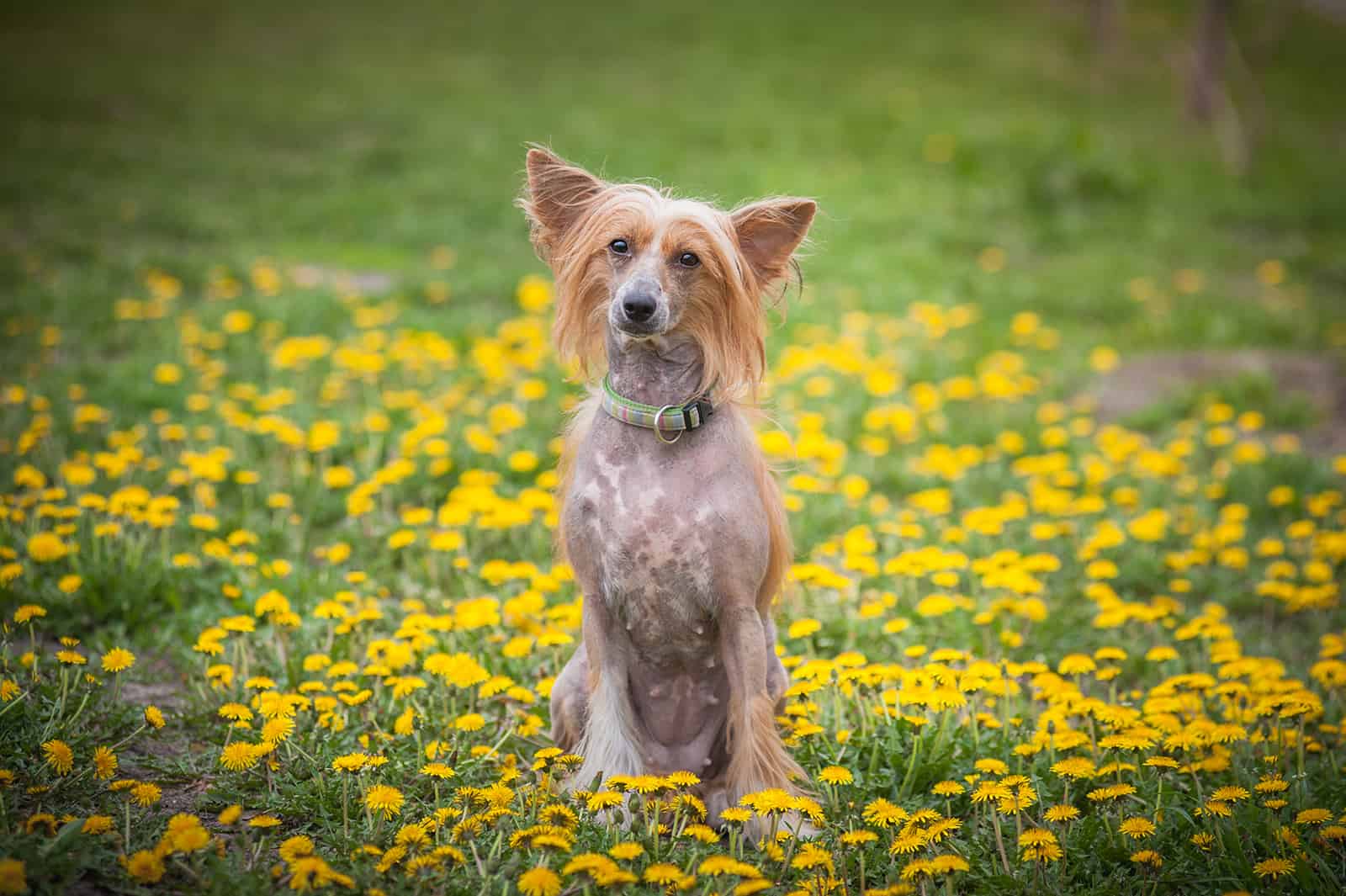
The next small dog breed on our list of Chinese dog breeds is one that’s actually not Chinese in origin but bears the name Chinese Crested Dog—multiple members of this dog breed also bear the title of the world’s ugliest dog.
The exact origin of the breed is a mystery, although it is believed to have descended from African Hairless ratters that were subsequently reduced in size by the Chinese, who preferred smaller breeds.
For centuries, Chinese Crested Dogs were used by Chinese sailors as ratters aboard their ships—during the time of the plague, Chinese Crested Dogs were used to hunt rats that carried diseases aboard ships.
Today, there exist two main types of Chinese Crested Dogs and they‘re often born in the same litter—the hairless Chinese Crested, which only has hair present on its head, feet, and tail, and the Powderpuff Chinese Crested, which has hair all over its body.
The Chinese Crested’s Characteristics
The hairless Chinese Crested Dog is more commonly seen due to the hairless gene being dominant in these dogs, although powderpuff Chinese Crested dogs are not extremely hard to find. If you stumble upon a reputable Chinese Crested breeder who happens to breed both types, then you can consider it as good luck!
The Chinese Crested Dog is eager to please, friendly, affectionate, and playful—most of them will often try to grab your attention through tricks and quirky behavior, just to get a bit of loving.
Their amiable natures and friendly dispositions make Chinese Crested Dogs ideal family companions—they get along well with older children and seniors and are not too energetic.
Another plus for potential Chinese Crested owners is that these dogs are hypoallergenic—along with having almost no fur to speak of, they are very low-shedding, which is good for people who suffer from allergies.
One potential downside to owning a Chinese Crested Dog is that these little dogs are very vocal—like most other small dog breeds, these dogs will bark at the slightest disturbance.
But this could also prove to be a plus, since their vigilant nature makes them excellent watchdogs.
Fun Facts
• One very unusual trait that these dogs exhibit is their love of heights—often compared to cats due to this peculiar trait, Chinese Crested dogs love to climb up anything and everything that will give them a high vantage point—maybe it’s just a remnant from their sailing ancestry and they’re just waiting for their moment to shout “land ahoy.”
• Since 2002, 9 Chinese Crested Dogs have won first place in the World’s Ugliest Dog competition held each year in Petaluma, CA.
17. The Japanese Chin
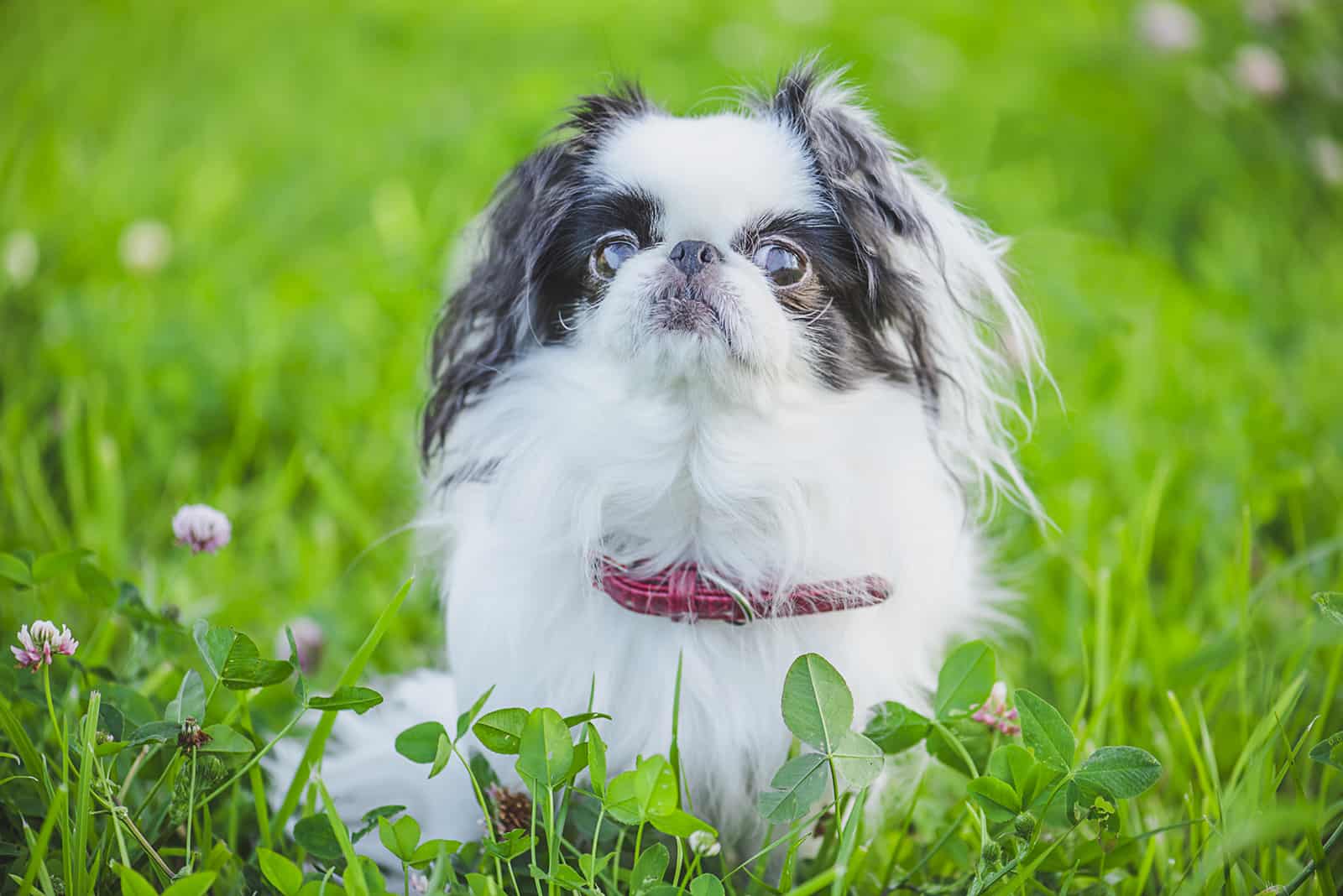
The next small dog breed on our list of Chinese dog breeds is the Japanese Chin—and no, we promise that we’re not cheating when we say that this dog breed is actually Chinese.
The Japanese Chin is believed to have originated in China—in fact, due to its uncanny similarity to the Pekingese, it’s thought that the Japanese Chin was developed from the Pekingese at some point.
Although they originated in China, the reason why they’re called Japanese Chins is that they were actually first popularized in Japan.
Even though there’s still an ongoing debate among dog aficionados about whether it originated in China or Japan, the fact remains that this adorable dog breed is a wonderful companion dog that fits well into any loving family.
The Japanese Chin’s Characteristics
Just like the Chinese Crested Dogs, Japanese Chins are renowned for their cat-like behavior—they often tend to paw at their faces and seek high ground to rest on, much like cats do.
Originally bred as lap dogs for the wealthy, Japanese Chins still retain their affectionate nature toward their owners—they’re eager to please, friendly, and will often perform tricks to get their owner’s attention.
When a Japanese Chin gets attached to you, it gets so clingy and affectionate that it often won’t leave your side—it’ll sleep close to you or even on top of you, and will often lick your hands, which is a sign of trust and love.
However, like most small dog breeds, Japanese Chins can sometimes be stubborn and independent, which is why training them can prove difficult for some people.
Although, when they’re properly trained and socialized at an early age, these dogs make excellent family dogs and are able to adapt to pretty much any living environment.
Fun Facts
• The first pair of Japanese Chins to step on US soil were brought here by none other than American Commodore Matthew Perry (and no, we‘re not talking about the actor from the famous sitcom Friends) in the 1850s—but this pair of Chins were not subsequently bred in the US, and they’re not the parent dogs of the Japanese Chin bloodlines in the US.
• The most popular trick that Japanese Chins love performing is called the Chin spin—they spin around in circles when they’re excited, and sometimes even get up on their hind legs.
18. The Tibetan Spaniel
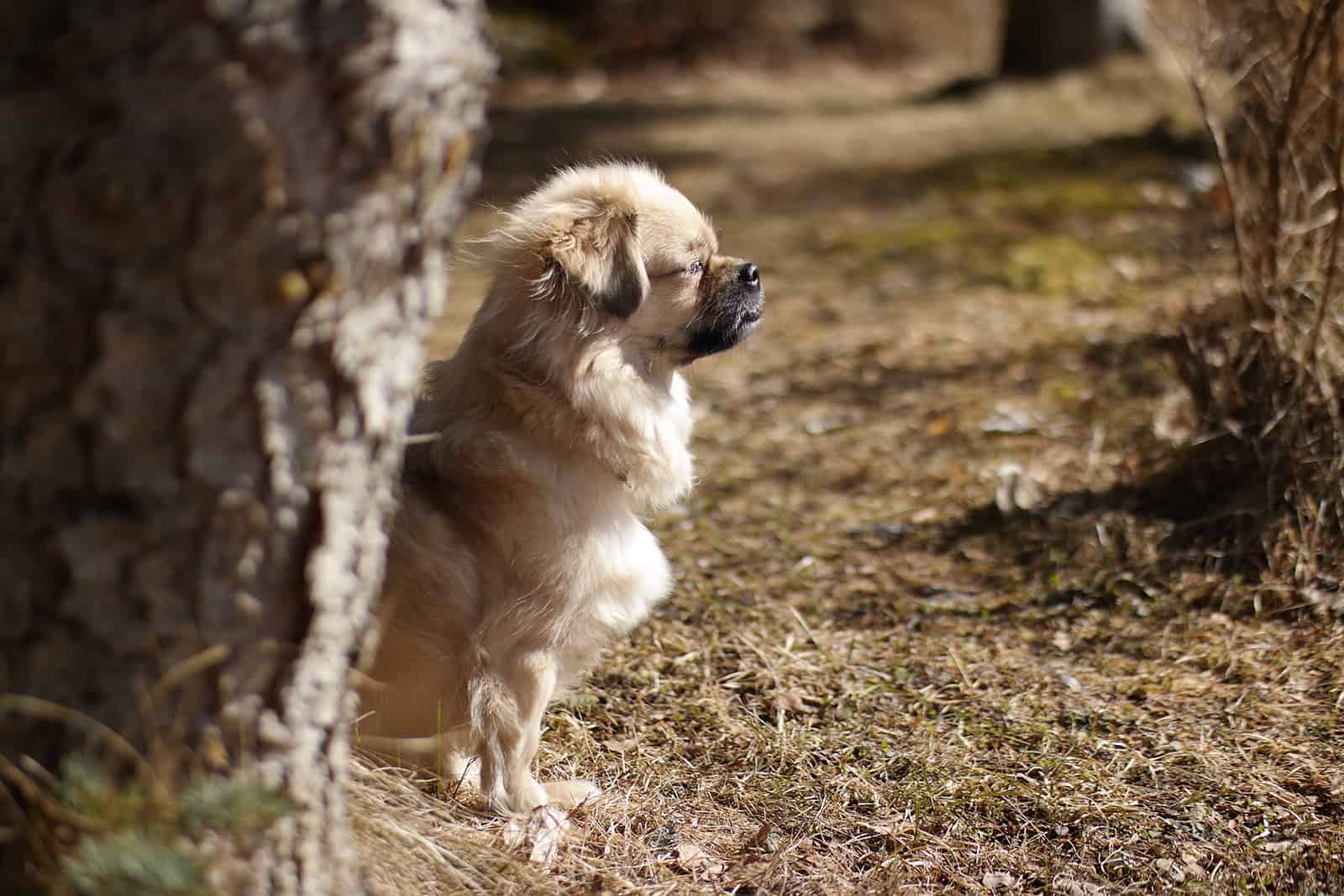
Next up on our list of Chinese dog breeds is another small dog breed that has shared ancestry with the Pekingese, the Japanese Chin, the Shih Tzu, and the Pug—the Tibetan Spaniel.
Although it‘s named the Tibetan Spaniel, this dog breed is not actually classified as a Spaniel breed—it belongs to the toy dog group but has the name Spaniel due to its close physical resemblance to Spaniel breeds.
It’s another ancient Chinese dog breed that originated in the Himalayas on the Tibetan plateau around 3,000 years ago and was used as a watchdog in the Buddhist monasteries—much like its cousin, the Tibetan Mastiff.
The Tibetan Spaniel’s Characteristics
Tibetan Spaniels are affectionate lap dogs and are gentle toward their owners, but they are also avid watchdogs when they need to be—the juxtaposition of their kind disposition and their watchful nature makes them ideal family dogs.
They’re also very needy and affectionate, so they thrive best with owners who have plenty of time to dedicate to them—leaving your puppy alone for the first time might prove to be difficult, but it’s something that must be done in order to teach it that it’s not a big deal.
Generally speaking, Tibetan Spaniels love to lounge around and not do much of anything, but that doesn’t mean that they’ll be content with spending all of their time indoors—Tibetan Spaniels need a moderate amount of daily exercise in order to stay physically and mentally healthy.
Fun Facts
• Tibetan Spaniels used to be watchdogs for Buddhist monasteries, they would sit atop the high monastery walls and bark to alert the monks whenever someone approached.
• Although no one knows for sure how old the breed is, it’s believed that Tibetan Spaniels are at least 3,000 years old—and some experts believe that they may even be the predecessors of the Lhasa Apso and the Pekingese breeds.
• Meet Tilly, the Tibetan Spaniel who was born with Short Spine Syndrome.
19. The Tibetan Terrier
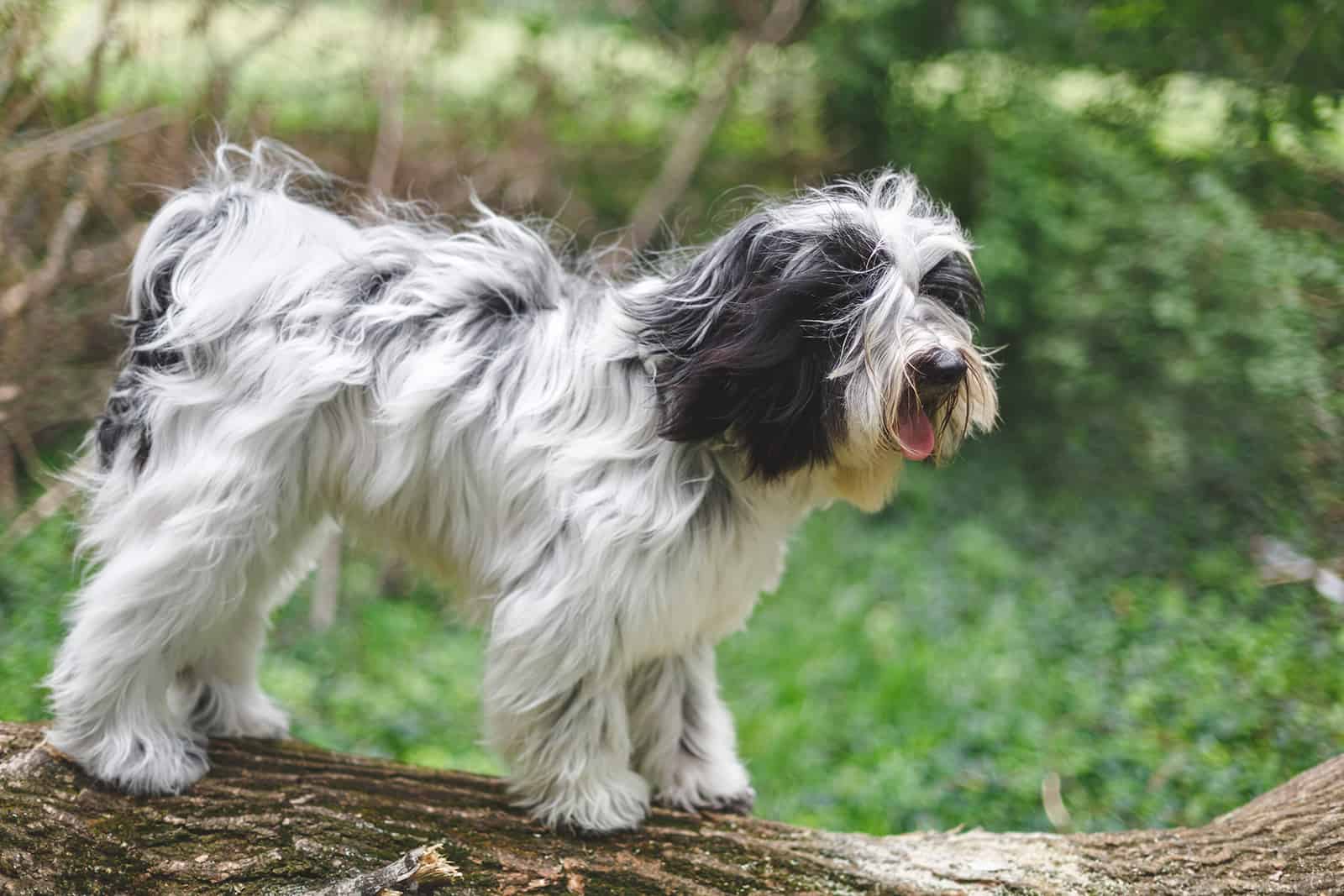
Next up on our list of Chinese dog breeds is another dog breed that has a confusing name—the Tibetan Terrier is a breed that’s not actually one of the Terrier dog breeds and is classified in the non-sporting group by the AKC.
The Tibetan Terrier originated around 2,500 years ago in Tibet—they’re one of the four dogs that were kept as watchdogs and guard dogs by the Tibetan Buddhist monks.
The Tibetan Terrier’s Characteristics
This shaggy dog breed is also known as the Holy Dog of Tibet—an ancient breed that is still popular today and is usually kept as a companion dog.
The most distinctive physical feature of Tibetan Terriers is their shaggy double coat that looks similar to human hair—this dense and wooly double coat is what enabled Tibetan Terriers to survive the harsh climate of the Himalayas.
Temperament-wise, Tibetan Terriers are family-oriented and are able to adapt to any living environment—their amiable natures ensure that they get along well with other dogs and small children, which is why they’re a popular choice of companion dogs for families all around the world.
Easy-going, laid-back, and calm, Tibetan Terriers can spend hours on end simply lounging around doing nothing, but they also enjoy spending some time outdoors with their owners.
What makes them a good choice for families is the combination of their affectionate nature and their vigilant watchdog instincts—considering that this is what they were bred for and originally used for, it should come as no surprise that Tibetan Terriers are suspicious of strangers but not aggressive toward them.
Fun Facts
• Tibetan Terriers have excellent eyesight and possess long eyelashes that prevent their long, shaggy hair from interfering with their jobs.
• They were considered an emblem of good luck and mistreating or selling a Tibetan Terrier was considered to bring bad luck.
20. The Manchurian Hairless
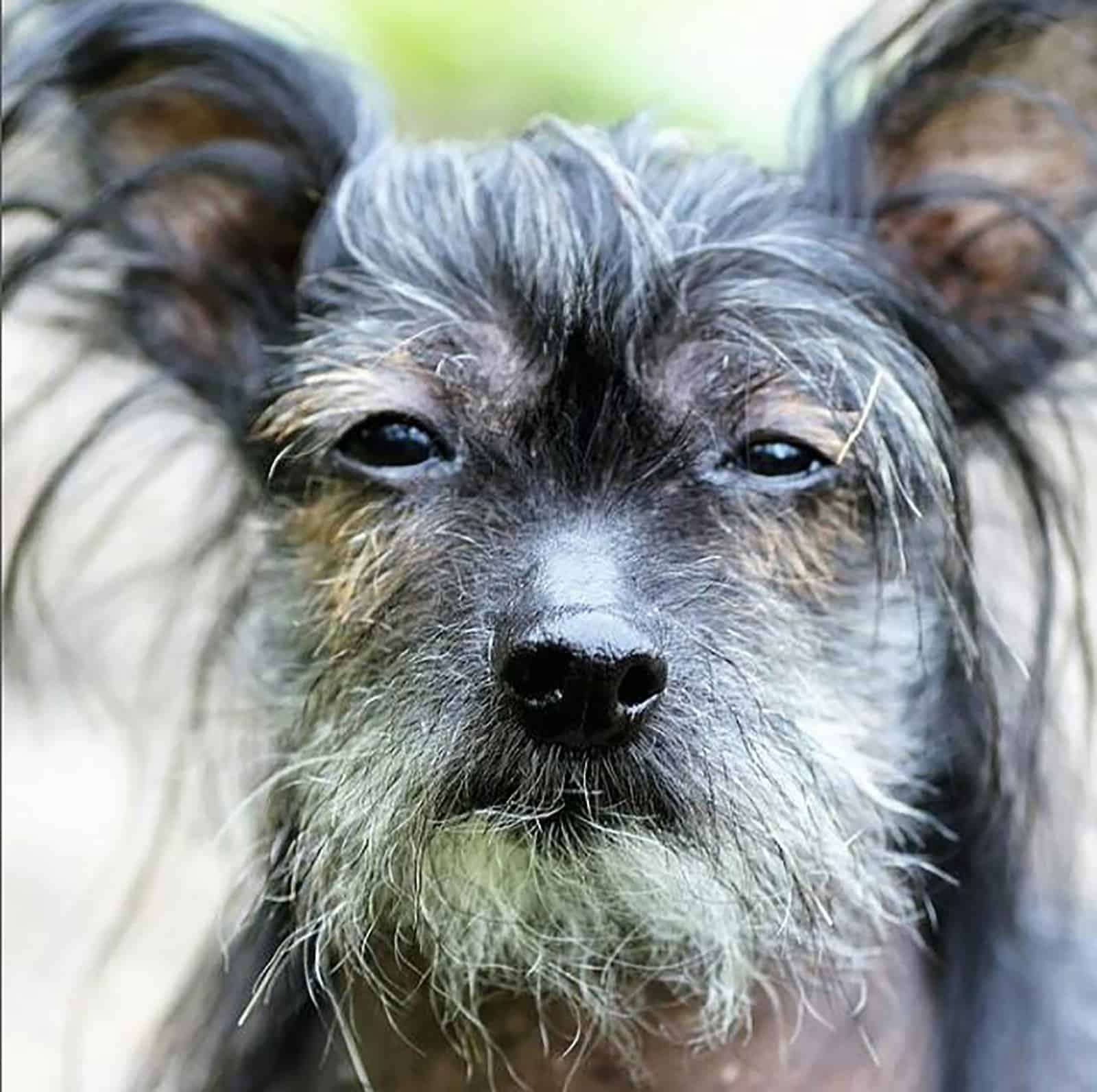
Photo from: @healthytail
The last spot on our list of Chinese dog breeds goes to the Manchurian Hairless—a cousin of the Chinese Crested Dog.
Although these two breeds are very similar in appearance, they are two distinct breeds— the Manchurian Hairless dog is also rarer than the Chinese Crested Dog.
Sadly, there’s not much that we know about the origin of this unique dog breed except that it certainly hails from China, and that it is approximately as old as its cousin, the Chinese Crested Dog.
The Manchurian Hairless’s Characteristics
Although they’re considered small dogs, Manchurian Hairless Dogs are slightly bigger and more agile than their Chinese Crested cousins—they were originally bred to be lap dogs and are still efficient at warming people’s laps now, centuries after their origin.
Temperament-wise, Manchurian Hairless Dogs are loyal, friendly, affectionate, and high-energy pups that require a lot of patience and time in order to flourish into well-rounded adult dogs.
They love being the center of attention and will often let just about anyone pet them, although since they‘re petite and fragile dogs, they’re not best suited for playing with small children who don’t yet know how to be gentle with dogs.
Although they’re small dogs that tend to bark at almost anything (and this trait makes them good watchdogs), they’re not the type of dogs that are going to do anything about an intruder other than simply warn their owners of impending danger.
In Conclusion
Phew, now that we’ve gone over the 20 Chinese dog breeds, both ancient and relatively modern ones—you surely have a clearer perspective and a new appreciation for some (if not all) of these unique dog breeds.
China appears to be the birthplace of the domestication of dogs and it has certainly contributed various dog breeds, in all shapes and sizes, to the rest of the world—so, you can go ahead and thank China for all the adorable, fluffy, and even intimidating dog breeds that they have introduced.
Related articles
• 24 Medium-Energy Dog Breeds That Might Be Suitable For You
• Teacup Dog Breeds – Tiny Dogs With Big Hearts
• Big Fluffy Dog Breeds – Big Dogs That Are Made For Cuddling
